T.E. Grau's Blog: Author Website, page 6
May 3, 2013
TC Book Review & Interview: Jordan Krall Branches Out from Bizarro and Establishes Strong Mythos Cred with 'Nightmares from a Lovecraftian Mind'
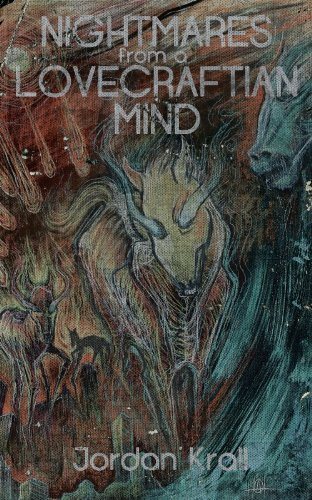
Jordan Krall impresses me. Yea verily, I am impressed by Jordan Krall.
Known primarily – at least to me, for a long period of time - as a Bizarro author, which is a limiting label in my even more limited opinion, I find Krall to be a bang-up Lovecraftian in that new jack Subtle School, and therefore someone I see as essential to a genre often cluttered by too many Cthulhu cameos and robed cultists who all somehow possess a copy of the Necronomicon. The stars are always right, and everyone’s favorite Great Old One is on the verge of rising once again to… do whatever he’ll do when he rises from that watery sleeping bag, jammies all soaked, pissy as hell. That’s Lovecraftian Pastiche 101. I've done it. Lots of us have. Jordan Krall could teach that class, if he wasn’t already admitted into the Miskatonic Graduate Program, where all the banners have been removed from the wall, and only those who are attending know on which campus they really are.
In his recent novella, Nightmares of a Lovecraftian Mind , published by Dunhams Manor Books, Krall cuts clean a Double Live literary concept album, where each titled chapter acts as a song that breathes on its own, but nods to the heaving collective. Pink Floyd on Yuggothian acid come to glistening life. This is post-Ligotti, impressionist Lovecraftianism – suggestive, urban, monumentally Weird, spontaneously murderous, and totally lacking in incomprehensible alien gods or even recognizable monsters, except for those who live down the block, or hang around the playground reading manuals on industrial parks. Krall creates vignettes that are familiar yet cold and otherwordly. Askew. Like when a movie crew films something that is supposed to be set in New York on the streets of Toronto to save a nickel and ruin America. We’re TOLD that we’re in SoHo, but none of the streets seem to fit. The landmarks are all absent.
Krall is a stylist as much as a storyteller, creating interesting, intersecting characters that could shoulder their own novels, based on their own internal cataclysms and the doom that follows each step. Osman and Xynobis, Roux and the nameless schmuck who fears an infestation of ants in his apartment - all of these doomed souls are begging for more pages. Themes prevail, following a wriggling through-line. Father issues and DEEP DENDO. Milk and alcohol (that's right - not scotch, not whiskey, but alcohol). These are a few of the unifying buzzwords and concepts that weave overarching throughout this work of sublime dread. Figure it all out, buddy. I have my theories. Pour me a double shot of alcohol, milk back, and you’ll get my interpretation, but it feels like Nightmares from a Lovecraftian Mind is a set up to be an encyclopedia mortis of KrallCraftian tomes. One can only hope.
The world he presents is a stark, threatening one, where every stranger and friend are bonded immediately by their shared wish for demise. Characters are disaffected, and for good reason, as chance encounters and innocent proximity often have dire consequences. And madness is everywhere, as everywhere is madness. From the doilies of the suburban home to the jerk-off booths in Times Square. The common is made dangerous, like Hitchcock run amok in a Steadman painting. This is Krall’s umbrella shielding a cosmic rain, yet the rivulets fall, making mad those dampened, one breath and random conversation from murder, or worse.
Krall’s prose is clean but rich, interesting in its word selection. He’s mature and jaunty. Saucy, weaving just a honey drop of poetic flair and dollop of HPL purple into his narratives. He’s the smart kid in the back of the room, who’s read more than you and knows the best dirty jokes. His chapters show that he is well versed in the trappings of the baroque, but prefers to downplay the baubles in favor of a cleanly wrought sentence. It’s quite the balancing act, and is seamless, with nary a stumble on the wire. Krall is joining his contemporaries in the genre in helping show us where Lovecraftian writing can go, without being chained to the increasingly played-out confines of the Cthulhu Mythos. Eerie, unsettling, smooth yet complex. Layered, odd, and infinitely quotable. These things are Nightmares of a Lovecraftian Mind.
That said, I feel like his title nods to the Cyclopean elephant not in the room, and will disappoint dilettantes who are expecting inscrutable chants, bloodied altars, and imminent global destruction, only to find a slow, ablated meltdown of a strange, cruel world. As the better Lovecraftian fiction continues to stray from the proud yet now prosaic roots of its birth, plumbing the depths of madness and fear rather than monsters in the sky, writers like Jordan Krall keep the cavalcade healthy and hale. As noted above, this is Grad School, kiddies, not 101.
Lynchian, Lovecraftian, Krallian. Can I make “Krallian” a thing? I sure as shit hope so, as I’m trying like the dickens to get Barronic as a certifiable adjective, so let’s work on Krallian next. The unformed Contempo Weird World is ours now, folks, so let’s start nailing down the lexicon and shoring up the perimeter.
I know he’s a hit in the Bizarro world, but I hope Jordan Krall stays and plays in County Lovecraftiana, as he adds so much to the geography. If he loves his readers – and Baby Jesus - at all, he’ll start writing a novel starring the oddly necromantic Osman tomorrow. If not, he’s a fucking dick.
___________________________________________________________________________
Below you will find a writer in transition, candidly discussing where he's been, his growth, and the new vistas he wishes to glimpse in the days to come. Check Jordan Krall's head to see where he's at, and see if you want to go with him. I'll save you a spot either way.

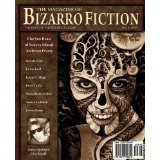 TC: Let’s start off with your recent announcement that sent ripples through the speculative and underground fiction community, in which you stated via social media that, in future, you will no longer - or only occasionally - write Bizarro Fiction. As someone who made his bones in the Bizarro scene through such works as Fistful of Feet and Beyond the Valley of the Apocalypse Donkeys, what moved you to make and announce this decision? Has there been a discovery of a new Muse that uprooted you from your familiar genre, or was your decision rooted in something deeper?
TC: Let’s start off with your recent announcement that sent ripples through the speculative and underground fiction community, in which you stated via social media that, in future, you will no longer - or only occasionally - write Bizarro Fiction. As someone who made his bones in the Bizarro scene through such works as Fistful of Feet and Beyond the Valley of the Apocalypse Donkeys, what moved you to make and announce this decision? Has there been a discovery of a new Muse that uprooted you from your familiar genre, or was your decision rooted in something deeper? 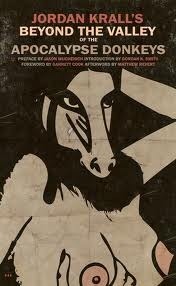 There are quite a few reasons for this and I won’t bore you with all of them now. But to make it short… my work has gradually been moving away from what can be considered ‘bizarro’ and in fact, one of the books you mentioned, BEYOND THE VALLEY OF THE APOCALYPSE DONKEYS, is not really one I would consider bizarro. The bizarro genre, for me, has become too constrictive and most of the books there lack depth. They are too concerned with just being “weird” that they sacrifice good writing and interesting plots. So much of it is juvenile and, for back of a better word, quite simple. I’ve found myself being bored by the output and sometimes even embarrassed by some of the creative decisions some of the authors make. Don’t get me wrong: there are a lot of talented writers there but I just think I’ve outgrown the genre itself. That’s not to say I won’t write another bizarro book. I will. It’s actually pretty fun to do. It just won’t be my chosen genre. I am also appreciative of it for giving me my start in writing professionally.
There are quite a few reasons for this and I won’t bore you with all of them now. But to make it short… my work has gradually been moving away from what can be considered ‘bizarro’ and in fact, one of the books you mentioned, BEYOND THE VALLEY OF THE APOCALYPSE DONKEYS, is not really one I would consider bizarro. The bizarro genre, for me, has become too constrictive and most of the books there lack depth. They are too concerned with just being “weird” that they sacrifice good writing and interesting plots. So much of it is juvenile and, for back of a better word, quite simple. I’ve found myself being bored by the output and sometimes even embarrassed by some of the creative decisions some of the authors make. Don’t get me wrong: there are a lot of talented writers there but I just think I’ve outgrown the genre itself. That’s not to say I won’t write another bizarro book. I will. It’s actually pretty fun to do. It just won’t be my chosen genre. I am also appreciative of it for giving me my start in writing professionally.TC: When did you know that you were going to be a writer, and what led you to this realization?
I remember being about ten years old and writing stories but they were, of course, quite crappy. Then as a teenager I got a little more serious about it but I mostly wrote cryptic poetry and stories that were overly influenced by Burroughs. I stopped soon after and didn’t start again until I was about twenty-five.
TC: What was your first brush with H.P. Lovecraft? What is your favorite HPL story? What are your plans as far as writing what would be considered “Lovecraftian fiction” going forward?
I don’t know how I discovered Lovecraft, but it was when I was about twelve or thirteen years old. I remember sitting in Barnes & Noble (this was during the time they frowned upon people sitting and reading in their stores) and looking through all the Bantam paperbacks. To me, HPL symbolized the unknown, the mysterious occult side of fiction. I knew that Cthulhu and the Necronomicon weren’t real but it was exciting to pretend it was, to pretend there were sinister cults of worshippers out there.
TC: Nightmares of a Lovecraftian Mind is quite an achievement. What was the genesis of this “concept collection”?
I just decided to pour all of my love for Lovecraftian and “cosmic” horror into a collection. That being said, I made sure to stay away from the usual tropes that have flooded the weird fiction genre. I do not use Lovecraftian plot devices or anything. I tried to modernize the subgenre while also making it really personal. In addition to HPL, I was also very much inspired by the writing of Wilum H. Pugmire and Thomas Ligotti.
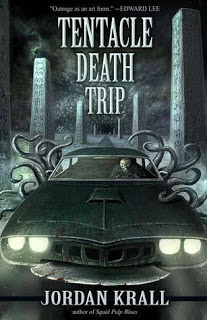
TC: With Squid Pulp Blues, Tentacle Death Trip, and now Nightmares of a Lovecraftian Mind under your shiny ass belt, you’ve obviously explored the HPL Mythos quite a bit and established your cosmic horror credentials. As such, where do you feel you fit in with the wider Lovecraftian Fiction scene?
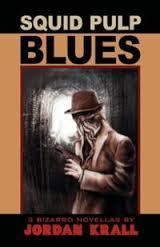 My goal is to appeal to readers who want weird fiction that’s outside the norm without being pretentious or derivative of HPL. I suppose I’ve also created my own mythos… not necessarily on purpose but as a result of writing within my
My goal is to appeal to readers who want weird fiction that’s outside the norm without being pretentious or derivative of HPL. I suppose I’ve also created my own mythos… not necessarily on purpose but as a result of writing within my own mental framework. Wow, did that make any sense at all?
TC: Actually, it makes perfect sense. Shifting gears away from Lovecraft, you have recently written and released several chapbooks and novellas through Copeland Valley Press, including False Magic Kingdom, Bad Alchemy, and The Gog and Magog Business. Tell us a little about these.
Those books are three in a series of four books. The last is a novel called YOUR CITIES, YOUR TOMBS. The series is my exploration of paranoia, anxiety, terrorism, fatherhood, marriage, etc. People will be surprised by these books as they lack the explicit sex and violence of my previous work. That being said, I believe these contain some of the scariest and most disturbing scenes I've ever written. I tried very hard to put my own fears into this book to an almost unhealthy degree (I am particularly afraid of tall buildings). Also, I was heavily inspired and influenced by J.G. Ballard, Barry Malzberg, and William Burroughs as well as a multitude of nonfiction books. It’s probably the most personal of anything I’ve written thus far.
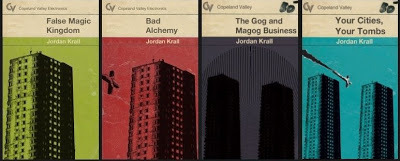
TC: You are the Founder and Galactic Overlord of Dynatox Ministries. What’s your goal for this promising limited edition indie press?
My goal is to publish really interesting books… the kind of stuff that I myself would like to read. I don’t limit genres either. I prefer more offbeat work but as long as it’s good, I’m open to it. Horror, absurdist, surrealism, nonfiction, etc. In most cases, I give authors a blank check in terms of what they can write. It’s mostly an “invite only” press so far because there are some authors I really want to work with.
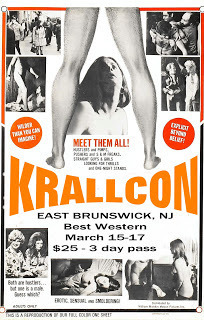 TC: What’s the deal with Krall Con? Is this a legitimate convention, or just a bit of inspired japery? How was the debut gathering?
TC: What’s the deal with Krall Con? Is this a legitimate convention, or just a bit of inspired japery? How was the debut gathering? Well, it started off as a little joke but turned into a legitimate gathering of writers and readers. It was a bit tiny but we had about four motel rooms at our disposal and lots of fun was had. Readings, a David Lynch trivia contest, impromptu film making, and even a really disturbing dance party. This year it was about a dozen people but next year I’m expecting more. I’d really like to raise money in order to hold it somewhere bigger or at least rent out a hall so we can have live music.
TC: To recap the Year of Krall so far, 2013 has brought us Dynatox Ministries, the first annual Krall Con, your move away from Bizarro, and now a series of compelling paintings. To what do you credit this expansion and transformation of your creative impulses?
I don’t know, really. I guess I just have a bunch of pent up creativity and I can’t help but let it out in every way possible. I also make music so that’s yet another way I vent. There are simply not enough hours in the day, though.I wish I didn’t have to sleep.
TC: What are you personally working on right now as a writer? Any new Lovecraftian/cosmic horror in your – and our – future? As an editor/publisher, what is Dynatox working on at present?
Yeah, I’m working on expanding NIGHTMARES FROM A LOVECRAFTIAN MIND for the paperback release. For Dynatox, I have so many awesome projects coming, it’s ridiculous. This summer I’m publishing a 6-book set of nunspolitation novellas from several talented authors: Nick Cato, Chris Bowsman, Jonathan Moon, Alex S. Johnson, R.A. Harris, and yours truly. The set will be housed in a wooden box and will be limited to 10 copies. Five of the books will be available for sale separately but mine will only be available with the box. I’m very excited about this.
TC: Thank you, Jordan, for enduring these annoyingly probing and often inane questions. The Cosmicomicon will be watching your career closely. Uncomfortably close.
Thanks, Teddy.
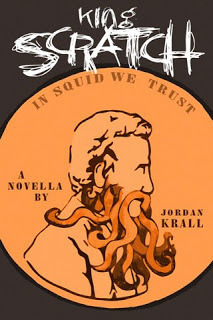
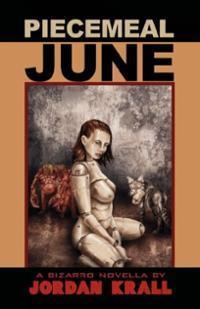
Published on May 03, 2013 11:32
April 30, 2013
Editing News: T.E. Grau Named Managing Editor of Science Fiction Horror for Dark Regions Press, Which Launches First Dedicated Sci-Fi Horror Line in Independent Publishing
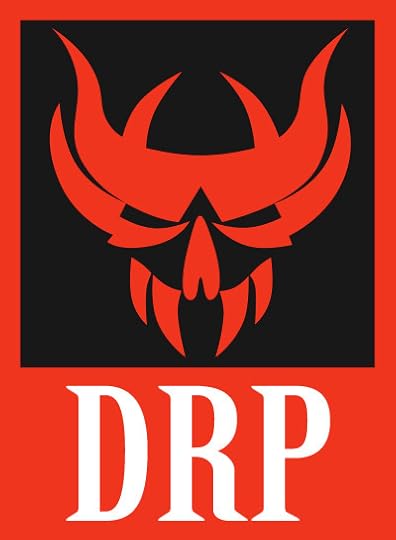
I am extremely proud to announce (via a headline written in the third person, something that makes T.E. Grau very uncomfortable) that I have been named Managing Editor of the new Science Fiction Horror line at Dark Regions Press , which - to my knowledge - is the very first dedicated Science Fiction Horror line to emerge in independent publishing.
I am a Horror fan, as a reader, writer, editor, and essayist. As a thinker, and as a dreamer. I like looking into the nighted places, and seeing what might be peering back. And I've always been like this, as I think I'm just wired this way. I don't believe that you can artificially engineer a Horror fan (although certain experiences or trauma can turn one's interest toward the shadows). Like handedness or an ear for music, you're either born with The Dark Curiosity, or you're not.
Being a Horror fan is simple enough to explain when discussing the topic with civilians, as they all picture a slasher film sequence throughout the whole conversation, or cheap Halloween props. But when you hash out the subject with a fellow Horror acolyte, it gets a little more complicated, and a few initial parameters must be determined before the conversation can continue: "Yes, you're a Horror fan, but WHAT KIND of Horror do you like?"
You see, Horror can be (and often is, for both better and worse) divided into numerous subgenres. Starting with supernatural or non-supernatural, you break it down further into ghost stories, urban fantasy, Weird, zombie, cosmic, vampire, werewolf, psychological, subtle, folklore, splatterpunk, witchcraft, possession, etc... And then there are the slipstreamed mash-ups, that take us out toward infinity. Each slot has its tropes and its fans, which means it has its loyalists. And that's great, as loyalty to genre is what keeps alive the greater beast of Horror, propped up by a thousand pairs of tiny, disparate legs, all moving in a different direction, but all still keeping Horror upright and moving.
Horror isn't horror these days with its genres, and the genre I will be overseeing for Dark Regions Press is Science Fiction Horror.
You see, the more I learn about the Horror genre, the more I am understanding my place under this wide, wondrous tent. I don't think I am a traditional (or conventional) Horror fan, as much as I am a fan of Weird fiction and Cosmic Horror, the latter of which is based in Science Fiction, of the kind practiced so well in the Pulp fictionists of the early 20th century.
As a devoted Cosmicist, I think about the sorts of short stories and novels I like to read, and the types of films I enjoy watching. The Thing is my favorite horror film (followed by The Texas Chainsaw Massacre , which is more a traditional horror/slasher/chainsawy film). H.P. Lovecraft is my favorite Horror/supernatural fiction author. Of my modern writer peers, I prefer those who include at least a smattering of cosmicism in their stories, no matter how subtle. It's not essential, but it does immediately catch my eye, and my interest.
So, to not put too fine a point on it, and without taking into account acumen or shortcomings, I feel that I was tailor made for this job, as Science Fiction Horror is my favorite type of genre horror Horror, more so than, say, Urban Fantasy or Splatterpunk or ghost stories.
To explain why, I'll let pictures do the typing...
This is Science Fiction Horror:
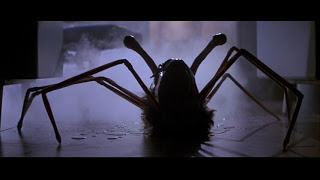
As is this:
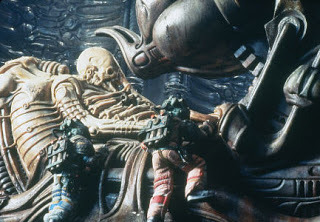 And this:
And this: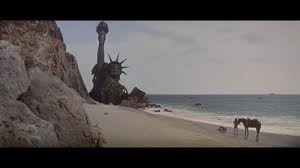
And these guys:
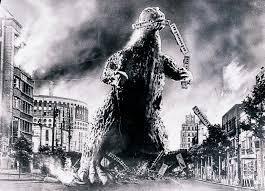
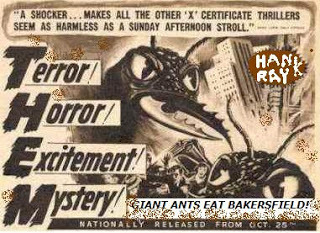
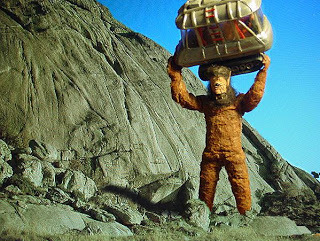
And that handsome fellow over there to the right:
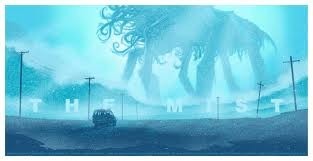
And those things:
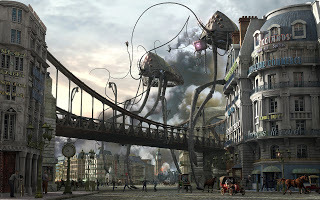
Even this:
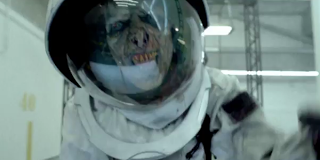 And especially this:
And especially this: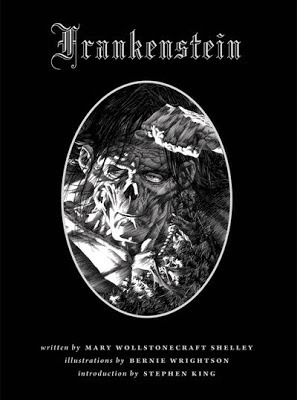
In fact, that last one is where Sci-Fi Horror all started, inside the mind of a teenage girl. Now it's time for us to continue this proud heritage, of producing Horror stories infused with technology, alien influence, interstellar (and inner earth) exploration, experimentation gone wrong, runaway science, genetic tampering, doomsday following Doomsday... This is Science Fiction. This is Horror. This is the new Science Fiction Horror line at Dark Regions Press.
Please find below an excerpt from a recently conducted interview with noted reviewer Justin Steele of The Arkham Digest , who was kind enough to let me share it here on the old TC mothership:
AD: Dark Regions Press is one of the most successful small press publishers, putting out quality work for over two decades. What are you bringing to the team?
TEG: I hope that I’m bringing a keen eye for quality writing, first and foremost. I approach my position as not only an editor, but also as a writer of genre fiction, and a huge fan, as well. I will seek out authors and help develop projects that I view as the best available from the ever-expanding pool of talent working in speculative fiction, both new and established.
I want to discover and secure the best in contemporary Science Fiction Horror Fiction, and cover art, adding to an already proud roster of DRP authors and impressive catalog of books.
AD: What kind of science fiction horror works for you? What are some examples of novels/short story collections and authors that hit what you feel to be the mark when it comes to the science fiction horror genre?
TEG: Something imaginative and bold, and not derivative at its core. I’m not a big fan of bandwagon horror, where every new story sounds like the last, to take advantage of some marketing flashpoint or cultural trend. I’m not looking for sparkling vampire stories or florid romance between supernatural creatures… in space. I want something ORIGINAL and compelling. I want something terrifying, and profoundly unsettling. I want a great story, constructed of great prose, be it baroque or Spartan. I’m a style hound, but those styles can vary, as long as the story is interesting, and appeals to our readership.
As for what authors of Science Fiction Horror might fit my ideal, my answer will be a bit hazy, as Dark Regions is one of the few - and possibly only - publishers that now has a stand-alone, dedicated department devoted solely to Science Fiction Horror, and only Science Fiction Horror. Chris Morey wants to break new ground in this area, and I want to help him do just that, building the brand and helping add additional accolades to a strong, fair-dealing publisher devoted to bringing the best of speculative fiction to readers and the wider Horror, Fantasy, and Science Fiction marketplace.
So, back to the question: I don’t want to name any particular authors, collections, or novels as my favorites, as I’m bound to leave someone out of my specific praise, so I’ll wuss out and default to the sorts of Science Fiction Horror films and television series that appeal to me, starting with John Carpenter’s The Thing, which is my favorite horror film of all time. Other examples of great - or at the very least, interesting – Science Fiction Horror on the big and small screen include Alien, Frankenstein, The Mist, Planet of the Apes, Blade Runner, The Fly, War of the Worlds, Invasion of the Body Snatchers, Alien Nation, The Terminator, The Blob, old Japanese monster movies, 1950’s and 60’s American science fiction creature films, Dr. Who, Lost in Space, the original Land of the Lost and original V, The X-Files, and more recently, Cloverfieldand Prometheus, although I had issues with both. Zombie and post-apocalyptic films count, as well, as long as they have a definite futuristic/science fiction backbone. Stories that echo some of these themes are all fair game, and will have my immediately interest.
And, as a proud reader, writer, and supporter of Lovecraftian fiction, I’m a sucker for Cosmic Horror, as long as its not Mythos-heavy pastiche.
AD: So as the managing editor of science fiction horror, what kind of work are you looking for?
TEG: I’m looking for anything that pushes the boundaries and has a unique voice. Familiar tropes are okay, as it becomes increasingly difficult to create something 100% original as more and more stories are penned each day, but if the setting is prosaic, make what happens and by whom original and unique in some way.
It can be epic and galactic, or it can be small and intimate. It can experimental, it can be slipstream, it can even be conventional, as far as setting and other tertiary elements. It just has to sing. Overall, I’m tough, but not a snob. I enjoy a good breezy read as much as a deep, thought provoking piece, as long as it’s well written. Now, describing what good fiction looks, sounds, and tastes like compared to bad is nearly impossible, but you certainly know both the former and the latter when you come across it. I want to read – and DRP wants to publish - the good stuff, and won’t settle for anything less.
So, if you have a novel or novella that you think fits the bill, have someone put a bird in my ear. We aren’t accepting general submissions, and will be operating by invite and referral only, so if I don’t know about an amazing work of Science Fiction Horror that needs to see the light of a dying sun, find a way to bring it to my attention, and I’ll take it from there.
AD: Do you have a "manifesto" or any goals that you've formulated going into this new position?
TEG: My main goal is to continue the tradition of excellence and success that Dark Regions Press has established and maintained for just shy of three decades. That’s incredibly impressive. As other indie presses have risen and fallen (sometimes in quite surprising and/or painful fashion), DRP has remained, and I take that decorated longevity very seriously in my mission to keep the brand vibrant and strong.
Following that, the ambitious editor in me would like to elevate – if possible – the quality of book that DRP puts out, from the inside out. Even the best can always improve, and I think with the recent staff additions to the company (including R.J. Cavender of Cutting Block Press fame joining as Managing Editor of Horror), Dark Regions is looking to grow and advance, becoming a bedrock for the very best in Horror, Fantasy, and Science Fiction – and all the delicious amalgamations of the same – in the field today. My manifesto is to make that happen, and I’ll be dogged in this pursuit.
Thanks again to Justin for inviting me to interview at The Arkham Digest, and allowing me to share a portion of our Q&A here.
NOTE TO AUTHORS : I will be reaching out to various authors, to gauge their interest in producing something for the line, and/or to see if they have anything already written, currently in progress, or on the docket that would be appropriate. And while I know many fantastic writers, I don't know them all, and there are so many talented scribes doing work that I have never read.
As such, I am accepting a limited number of queries for completed SFH novellas/novelettes/novels (no collections or anthologies at this time, please), sent to [email protected]. If the brief synopsis looks like something we are looking for and/or sparks my interest, I will ask for an extended synopsis and a sample of the first three chapters. At that point, I should know what I'm dealing with, and with whom. As these query numbers are limited, I reserve the right to close them at any time, once I have enough/too many potential projects to work through. They may or may not open back up again, depending on the quality and volume of queries I have received during this initial query period. Dark Regions Press operates on an invite-only basis, but to get the SFH line started, I feel that I need to cast a wide net, at least initially, to see what's squirming around out there.
Let's be honest - publishers want to sell books, and books written by recognizable names will move better than unknowns. BUT, what we want first and foremost are EXCEPTIONAL STORIES around which to wrap our label. Properly prepared dung only burns hot for a brief second, like a cheap candle that lights up the room and gutters out, leaving a disagreeable odor behind. Dark Regions Press has been and will remain in this industry for the long haul, and in this spirit, we want to put out the best books on the market, in all of our genres, which includes Science Fiction Horror. Books that will endure, and help define (and possible re-define) contemporary Horror fiction.
A publisher is only as good as their authors (and artists). DRP has published books from some amazing talents already, and now its time to continue this trend of quality going forward, which is where you just might come in. Impress me. Dazzle me. Leave me terrified, or wonderstruck, or both. Most of all, leave me wanting more.
I'm so very humbled and excited to be working for Dark Regions Press (joining the esteemed R.J. Cavender, DRP's new Managing Editor of Horror, in the dugout), and eager to get started. Write hard, spread the word, and hit me up with the best that you've got. The possibilities in Science Fiction and in Horror are endless, and endlessly fascinating. Break me off something special, and let's tear down the sky.
Published on April 30, 2013 11:57
April 29, 2013
TC Anthology Review: Horror Anthology 'Shadows Edge', Edited by Simon Strantzas for Gray Friar Press, Cuts Deep and Fields Strong

With Shadows Edge (Gray Friar Press), dark fiction writer Simon Strantzas has put together an evocative and beautiful anthology of subtle Horror that follows a texture championed and furthered by Strantzas throughout his acclaimed career as an author. Indeed, the tales reflect the man at the selector switch, as each of the 16 assembled pieces (including a “short story as prologue” by Strantzas himself) represent works of patient, often quiet weirdness and terror that get under ones skin rather than braining you with a cudgel. These stories fit into the category of what Strantzas himself personally creates as a writer, so it stands to reason he’d release an anthology of similarly styled works that resonate with him as editor. He states in his Afterward that the theme of the aptly titled anthology is exploring those “thin places,” “soft spots,” and “cracks in reality” that separate our world from those vistas and realities that lie beyond what we know to exist. The edge separating light from shadow. In their own way, each of these stories successfully lives up to (and thoroughly explores) this nuanced theme, and do so in spades.
Thin places.
Where worlds crash against each other,
rippling soft spots through reality.
Ancient portals through which the darkest nightmares seep,
spreading uncertainty and doubt.
These places haunt us, and from them
shadows edge.
A figure from the past, lying in a field...
The unlikely three, bound by their quest...
A high-rise apartment, where creatures crawl...
The drive in the storm, through blurring edges...
The brother, hiding from his sins...
Most anthologies these days have their hits and their misses, with the best books of the bunch having more of the former than the latter. But with Shadows Edge, no matter how hard I squinted, I had – and have – a very difficult time finding a broken crayon in the box. These are 16 solid-to-great tales, and reflect well on the talents of their individual creators, as well as Strantzas ability to wrangle excellent stories from some of the top names in speculative fiction today.
The standout tales (in ToC order) among the uniformly strong field are many, and include Joel Lane’s “Echoland,” Richard Gavin’s “Tinder Row,” “The Falling Dark” by Daniel Mills, Gary McMahon’s “The Old Church,” “Morning Passages” by Lisa Hannett, “Stabilimentum” by Livia Llewellyn, Peter Bell’s “The True Edge of the World,” and “Bor Urus” by John Langan.
Among these, I found “Echoland” (a story about questing after a doorway to that glimpsed land just behind the veil), “Morning Passages” (a truly original natal piece that reads like something out of a more brutal version of the Twilight Zone), “Stabilimentum” (a woman must deal with an infestation of spiders in her new dream apartment that becomes the very least of her startling discoveries about where she now lives), “The True Edge of the World” (for my cash, the highlight of the book, due as much to Bell’s writing style and description of the Scottish setting as the folklorish supernaturalism), and “Bor Urus” (a dissection of a man obsessed by violent storms, and what can happen during them, to the detriment of everything he holds dear) to be the crema fresca of a rather creamy crop, and some of the best contemporary short stories I’ve ever read. Lane, Hannett, Llewellyn, Bell, and Langan are now on my “must ALWAYS read” list, joining several other contributors to Shadows Edge who made the list many moons ago.
Stranzas has acquitted himself impressively in this his first anthology. As noted above, there isn’t a bad story in this folio. I just singled out those that appealed to me the most, for a variety of stylistic and story reasons. But all are worthy of praise, and especially worthy of a read. More collections need to taste like this one.
An unquestionable and enthusiastic HIGH RECOMMEND, receiving four and a half (out of five) stars on The Cosmicomicon's glimmer scale. Pick up this if you want to peruse some of the top talent in the Weird fiction/Horror game doing what they do best by exploring the thin spots in the veil, the hidden pocket of quiet dread, that make life so interesting, and worth living, as the more we know about what lies beyond, the less we want to end up there. Visiting via prose, however, is entirely another matter...
Published on April 29, 2013 17:35
March 26, 2013
Audio Fiction: 'The Screamer,' 'That Old Problem,' and now 'Low Hanging Clouds' All Available Oline in Free Audio Format
 (c) Rhys "Hidden Moves" OwensHearing sentences you first crafted in your own head (and then translated to the page by your fingers) spoken for the first time is always a trip. In fiction, we write our stories in our own internal voice, with distinct modulations, timbre, and emphasis, and then readers translate it into theirs, keeping the experience entirely unique and personal to both writer and consumer. It remains an echo chamber of the familiar. That makes hearing ones prose read aloud all the more interesting.
(c) Rhys "Hidden Moves" OwensHearing sentences you first crafted in your own head (and then translated to the page by your fingers) spoken for the first time is always a trip. In fiction, we write our stories in our own internal voice, with distinct modulations, timbre, and emphasis, and then readers translate it into theirs, keeping the experience entirely unique and personal to both writer and consumer. It remains an echo chamber of the familiar. That makes hearing ones prose read aloud all the more interesting. I spent nearly 12 years writing screenplays, and have seen my work spoken and acted out on the screen by others, who have no tie to the subject matter, or the source marrow from whence it was born. But that's screenwriting, which has its built-in limitations as far as playing with language. Unless you're Tarantino or Mamet, it's a visual medium, first and foremost, and the words - the sinewy pop of the language - are often gutted by directors, or pared down by actors that just can't get their mouths around what is was you wrote, or really wanted to write in the first place. It's a frustrating medium for writers in love with the full palette of language.
Back to the realm of fiction... I don't do readings of my own work, as I suffer from a crushing case of stage fright, and realize that if one isn't a natural orator or spoken word natural, the story might suffer in the pauses and fumbles in the vocal communication of the literary arts. So, readings can either bring life to a written work (if done correctly), or harm it in the ears, and mind, of the audience. It's a risky proposition, my friends.
The rise of audio books helped to change the entire dynamic, allowing skilled voice artists a medium to read aloud the work of a writer, away from the podium and the klieg lights. It is a more intimate experience, and can be an effective for a reader to absorb the words of a writer when unable to sit down and stare at a page or digital screen.
In the spirit of audio books (remember when they were called "books on tape"?), there has been a movement afoot lately, where works of short Horror fiction are read by voice artists, peers, and fans, and then posted online, offering yet another way for readers to stuff dark fiction inside their gourds, while also allowing writers a chance to hear their words translated through the brain of another, and then projected into the world by a objective voice.
I'm humbled to say that three of my stories have been read aloud, recorded, and are available for your listening pleasure right this very instant.
First of all, the wonderful Julia Morgan, aka Morgan Scorpion , honored me with a reading of my short story "The Screamer," published in Urban Cthulhu: Nightmare Cities . Morgan is a Lovecraftian/Weird fic fan who combines her talents as a voice artist to bring sound to so many pieces of classic and contemporary literature, including Poe and Lovecraft. Not surprisingly, I was quite happy when she asked if she could read "The Screamer," as I knew the story would be in good hands... er, vocal chords. Plus, what flatlanding Yank doesn't want to hear their work read in a British accent?
If you haven't clicked the link above, please check out Morgan's YouTube Channel.
___________________________________________________________________________
I wrote the story "Low Hanging Clouds" almost two years ago, then bribed author and editor Bruce L. Priddy with baubles, trinkets, and a hillock of cocaine to publish it on his now unfortunately retired e-publication Eschatology Journal.
About a year later, I stumbled across the Reddit dark fiction journal, The Library of Shadows, and decided to post up "Low Hanging Clouds" there, in an effort to whore myself in every conceivable area of the ether in a very unassuming way. I received a few lovely comments, and then thought nothing of it after that.
Soon after, David Cummings - who runs the fantastic horror storytelling broadcast site The Nosleep Podcast - read "Low Hanging Clouds" and tried to contact me through the Reddit e-mail system. Not being a Reddit reg, combined with my Cro-Magnon level of understanding of most contemporary technology, I never checked my messages, so I never discovered his inquiry about doing an audio reading of the story. Luckily, he took my e-silence as acquiescence, and read, recorded, and broadcast the story himself on the August 12, 2012 edition of the podcast. It's a fun listen. His zeal for the genre is undeniable.
_________________________________________________________________________
Lastly, but certainly not leastly, Mike Davis of the essential reading Lovecraft eZine published my story "That Old Problem" exactly one year ago, in March of 2012. In a coincidence of fate, Bruce Priddy, who also serves as an editor at the eZine, read the story for broadcast, hopefully while topless. You can download the audio version of the story at the top of the top of the page.
__________________________________________________________________________
So, if you're inclined, or just tired of reading all those icky, monosyllabic words, but still want to check out a bit of Weird/Lovecraftian fiction, please give these stories a listen, and more importantly, dig deeper into the linked sites and journals provided above.
Feed your head, lest it devour you instead.
Published on March 26, 2013 13:19
March 12, 2013
Strange Aeons: Issue #10 Available for Order, Featuring Comics, Reviews, News, and Original Fiction by Scott Nicolay; Issue #11 on Deck

Praise be to the snooty, antisocial gods luxuriating at the center of all creation - I survived my first year as Fiction Editor of Strange Aeons magazine, and there is no better way to celebrated my one year anniversary than Issue #10, which features a cover by SA fave Mike Dubisch, who created a beautiful, squamous wrap-around piece that is worth the price of admission alone.
But you get more than just the wrapping paper, friend. Lords of Light, do you ever get more... I'm talking about... er, writing about 52 pages of gorgeous color and B&W comics by Rob Corless, Vincent Ferrante, Ben "1314" Hansen, D.C. Stuelpner, Shelby Denham, and Eric York. And once again, another set of two fresh and wriggling Anno Ktulu collectible trading cards. We also have book reviews, news from around the Weird-o-Sphere, interesting adverts for outstanding fiction and other dark matter, and more. Yes, that's right, MORE. What is this "more," you might ask? I'm sure as hell not going to tell you, you nosy so-and-so, as the "more" in Strange Aeons remains a secret only revealed to those who order and hold our honest to goodness pulp mag in their soft, beautiful hands.
Of course, as Fiction Editor, I draw special attention to the prose piece we feature in each issue. For Issue #10, we have something truly special in Scotty Nicolay's story "You Are What You Eat," accompanied by an illustration from SA in-house artist and part-time limerick scribe Nick "The Hat" Gucker.
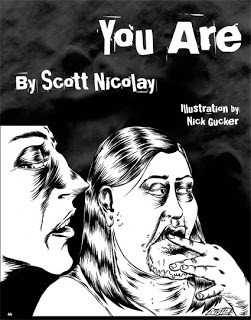 Scott has been generating the right buzz from the right people for a while now. Laird Barron has called him a writer to watch. He appears with me in the (now sold out)
Aklonomicon
, adding his story of cosmic horror in the South Pacific "Ana Kai Tangata" to the noxious mix. He has his debut fiction collection coming out in spring of 2014 from Fedogan & Bremer. After reading his story in the Aklonomicon, I decided to invite Scott to submit for Issue #10. And while I was hoping for - and expecting, to be quite honest - something great from Scott, I had no idea what he was sending me.
Scott has been generating the right buzz from the right people for a while now. Laird Barron has called him a writer to watch. He appears with me in the (now sold out)
Aklonomicon
, adding his story of cosmic horror in the South Pacific "Ana Kai Tangata" to the noxious mix. He has his debut fiction collection coming out in spring of 2014 from Fedogan & Bremer. After reading his story in the Aklonomicon, I decided to invite Scott to submit for Issue #10. And while I was hoping for - and expecting, to be quite honest - something great from Scott, I had no idea what he was sending me.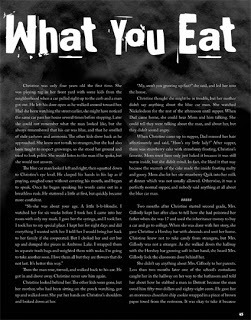 "You Are What You Eat" is quite literally one of the most affecting, extraordinary, and totally UNIQUE short stories I have ever read, unlike anything that has come out recently. It's a piece of not only Weird fiction but profoundly weird fiction, that is unsettling and brutal and sad, while at the same time oddly uplifting. I can't do it justice without giving anything away, and I'd rather gnaw off my index fingers than to that, as it would rob readers of a revelatory experience that ranks up with with first discovery that amazing band or movie or author that is so damn good you can't believe that everyone else hasn't heard of them, but at the same being thankful that not everyone has (yet), because for a little while, this beautiful secret is yours and yours alone, allowing you to share it with those whom you deem worthy, and then watch the word spread with a mixture of sadness and pride.
"You Are What You Eat" is quite literally one of the most affecting, extraordinary, and totally UNIQUE short stories I have ever read, unlike anything that has come out recently. It's a piece of not only Weird fiction but profoundly weird fiction, that is unsettling and brutal and sad, while at the same time oddly uplifting. I can't do it justice without giving anything away, and I'd rather gnaw off my index fingers than to that, as it would rob readers of a revelatory experience that ranks up with with first discovery that amazing band or movie or author that is so damn good you can't believe that everyone else hasn't heard of them, but at the same being thankful that not everyone has (yet), because for a little while, this beautiful secret is yours and yours alone, allowing you to share it with those whom you deem worthy, and then watch the word spread with a mixture of sadness and pride.For "You Are What You Eat," I share with you writer Scott Nicolay with neither sadness nor pride, as I certainly didn't discover him, and I want him to sell two million books. Writers this good need to, if we are ever going to re-balance the scales between bestselling schlock and small press exceptionalism.
While you're waiting for your issue to arrive via post, airlift, and/or trained fruit bat, feast on these page teases. FEAST ON THEM! Then go buy the magazine. Wood pulp doesn't grow on trees.
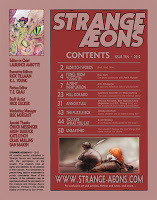
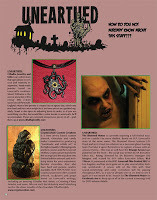
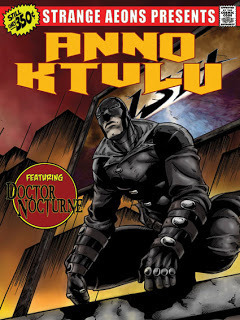
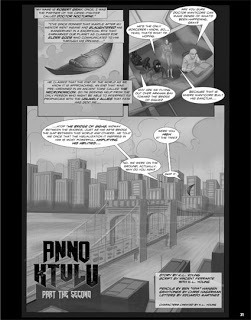 Issue #10 continues another chapter of "Anno Ktulu" (written by K.L. Young and Vincent Ferrante, pencils by Ben "1314" Hansen, graytones by Chris Hagerman, letters by Eduardo Martinez), a superhero story set amid the Lovecraftian Mythos, which debuted in serial form in Issue #9 after launching with an oversize, one-shot special edition currently available at the Strange Aeons mothership website. As noted in prior postings, the one-shot ties into the ongoing "Anno Ktulu" storyline that will be running all year in Strange Aeons. Get in on this innovative story of superheroes set in a Lovecraftian universe now, as you definitely don't want to miss this.
Issue #10 continues another chapter of "Anno Ktulu" (written by K.L. Young and Vincent Ferrante, pencils by Ben "1314" Hansen, graytones by Chris Hagerman, letters by Eduardo Martinez), a superhero story set amid the Lovecraftian Mythos, which debuted in serial form in Issue #9 after launching with an oversize, one-shot special edition currently available at the Strange Aeons mothership website. As noted in prior postings, the one-shot ties into the ongoing "Anno Ktulu" storyline that will be running all year in Strange Aeons. Get in on this innovative story of superheroes set in a Lovecraftian universe now, as you definitely don't want to miss this.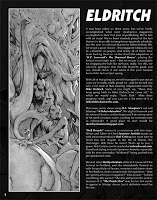
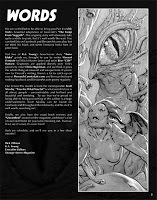
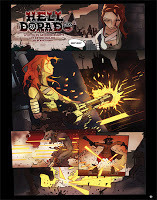
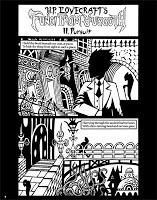
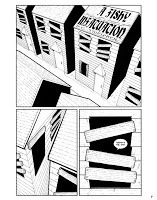
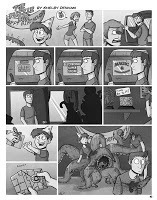
"Forbidden Lore" gives news and reviews devoted to the Weird, cosmic, and horrifying, and never in that same order twice.

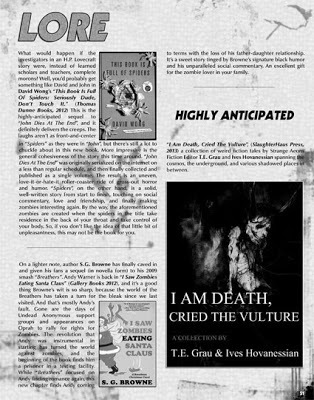 Who are THOSE people mentioned on the Arnaud de Vallois cover to I Am Death, Cried the Vulture? Bloody hacks!
Who are THOSE people mentioned on the Arnaud de Vallois cover to I Am Death, Cried the Vulture? Bloody hacks!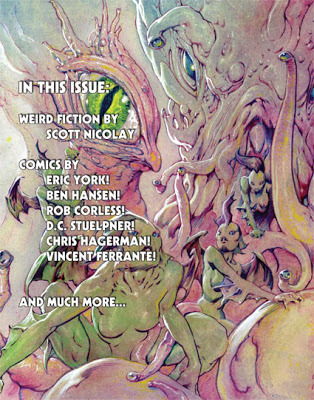
Have you ordered yet (Issue #10 or our many lovely back issues, prints, chapbooks, and T-shirts)? What, are you fingers broken? Strange Aeons continues the proud tradition of such classic Silver Age pulps like Heavy Metal , Creepy , and Eerie. You know you love this stuff. We love this stuff, too, which is why we do what we do. Check us out for the first time, if you haven't already. For those loyal readers, thank you from the bottoms of our flinty, twisted hearts for your ongoing support. We can't continue to pay people to create cool shit for us - and ultimately you - without subscribers and per-issue patronage. Stay golden, and we'll stay at it.
Issue #11 is now coming together, which will feature original, previously unpublished fiction by Gary McMahon, one of my favorite current horror writers, who also likes to make the rest of us feel like toadish turds with his karate, workout, and jogging updates. I was honored that he subbed, and pleased that I was able to accept his piece, which will continue the line of short fiction excellence established by Strange Aeons. Other stories shimmying in the pipeline will only add to the luster.
Stay tuned! Stay alive! Stay reading!
Published on March 12, 2013 13:18
January 4, 2013
The First Annual NecronomiCon Providence 2013 - Arriving August 23-25: Gearing up to Become the Premiere Lovecraftian Convention, Conference, and Celebration in the World
 (c) Abigail LarsonWe Lovecraftians are a scattered lot. From the icy reaches of Scandinavia, to the further tip New Zealand, from the Indian subcontinent to central Mexico - we dwell. Hell, I'd wager there are a few 'Craftians down Antarctica way, doing their occupational duty whilst keeping an eye on the horizon, looking for shadows cast by Mountains of Madness.
(c) Abigail LarsonWe Lovecraftians are a scattered lot. From the icy reaches of Scandinavia, to the further tip New Zealand, from the Indian subcontinent to central Mexico - we dwell. Hell, I'd wager there are a few 'Craftians down Antarctica way, doing their occupational duty whilst keeping an eye on the horizon, looking for shadows cast by Mountains of Madness.We are also prone to be a tad, say, "curmudgeony," to put it delicately. We have too many books to read and night skies to contemplate and stories to write and songs to sing to venture too far into proper, square society. When we do, it always ends up being such a waste of time, doesn't it? The hearth and page is never a let down.
Finally, we are diverse, as much as that would shock HPL, and as much as that constantly delights me. Cosmicism knows no race, gender, or creed. The fantastical doesn't choose followers. You either feel it in your marrow and up your tingling spine, or you don't.
All of these reasons - and many others - reinforce why gatherings devoted to Lovecraftiana are so important, and so interesting. It gets us away from our tomes and into a predetermined gathering spot, all within easy reach of cocktails. There is browsing to do and things to purchase - LOVECRAFTIAN THINGS! Familiar faces abound, as do new people to meet. The air is abuzz with happy talk of very dark things, and all seems RIGHT with the world amongst those who dream of days when the stars will be, too.
Now, conventions solely devoted to the works and influence of H.P. Lovecraft have come and gone over the years, but keeping that sustaining momentum going has been difficult. With that said, I'm here to inform you that this unfortunate sporadicism might be a thing of the past, as devoted Lovecraftian and local Providence resident (Providencian?) Niels S. Hobbs has put together what looks like the Mother of All Lovecraftian Gatherings - the Shubby of the HPL Con scene, if you will: NecronomiCon Providence 2013 , coming this summer (which will be here before you know it), August 23-25. After going through the planned program of this massive event, I think Hobbs and his ambitious band are going to accomplish their goal, folks. Read on and tell me I'm wrong...
Please note: This is a lengthy posting, full of wonderful and edifying information. As such, be sure to scroll down completely for information on becoming a reward-draped backer via the NecronomiCon Providence 2013 Kickstarter (LESS THAN FOUR DAYS LEFT!), and the official Call for Abstracts, for those of the scholarly bend (like I sometimes pretend to be).
First, some background, lovingly provided by the organizers of NecronomiCon Providence:

Howard Phillips Lovecraft, born in Providence in 1890, is widely considered to be the father of modern supernatural fiction. In tribute to his legacy, the Lovecraft Arts and Sciences Council, Inc., a nonprofit organization based in his hometown, is organizing NecronomiCon Providence, a multi-faceted convention exploring the works of Lovecraft, his contemporaries, and the modern writers and artists that he continues to influence. This three-day event will feature renowned speakers, panel discussions, and workshops. Participants will be further rewarded with historic tours, art exhibits, film screenings, plays, and concerts that will immerse them in the city he loved and called home – Providence, Rhode Island.
Unusual for an event of this sort, we are working to bring attendees outside the traditional confining walls of the convention hall and into the streets to showcase and celebrate the character of Lovecraft’s city. Working with the municipality, area universities, and local businesses, we are creating a convention that will draw many people to Providence, and help to maintain its status as a destination city, a city that Lovecraft venerated, and immortalized in the minds of countless individuals around the world. It was in this centuries old city that Lovecraft was born, and where his literary mythologies were formed – and those ancient strains still resonate here today.
Theme: “The Rational Mind in Supernatural Literature” – an exploration of the intersection of art and science that lies at the foundation of the H. P. Lovecraft mythos literary genre. The name NecronomiCon is a tribute to the fictional ancient book of knowledge he conceived in his stories, and serves to underscore this theme.
Date: August 23-25, 2013, to coincide with Lovecraft birthday celebrations in Providence.
Subjects to be explored over the three-day convention:
· Literature: Science Fiction, Horror, Mythology…
· Science and Exploration: Astronomy, Archaeology, Biology…
· History: Primordial, Pre-Colombian, Colonial, 1920s…
· Culture: Art, Architecture, Cinema, Theater, Music, Poetry, Gaming, Food…
Many of the foremost Lovecraft mythos scholars and writers have signed on to be a part of this event, including S.T. Joshi, Robert M. Price, W.H. Pugmire, Caitlin R. Kiernan, Laird Barron, and many others. To date, there is already so much positive buzz in the literary and pop-culture community surrounding our plans, that this is expected to be the preeminent Lovecraft conference of the decade, and the largest convention of its kind anywhere in the world.
As we move past the formative steps, we are looking for SPONSORSHIPS and GRANT SUPPORT to help implement this long-overdue tribute to Providence’s own begotten. After more than a decade since the last Lovecraft convention in Providence, the roots have set for a newly invigorated NecronomiCon in August 2013. If you’d like to be a material part of this, with an anticipated audience of upwards of a thousand hungry and passionate fans from around the nation and the world, please contact us via email or phone listed below or through our website.
Niels Hobbs, director
Email: [email protected] Phone: 401.743.3250 Web: necronomicon-providence.com
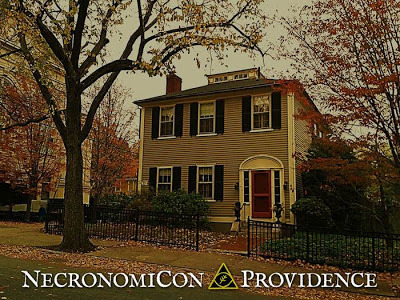
PROPOSED EVENTS
During the course of the three-day convention, NecronomiCon Providence will showcase a wide variety of engaging programs.
· Speakers and panel discussions covering all aspects of the Lovecraft legacy
· Art exhibits featuring local and international artists inspired by the tales of H.P. Lovecraft
· Film series highlighting cinematic works (full-length features and short films), including classics and new releases
· The infamous Cthulhu Prayer Breakfast, presided over by Robert M. Price
· Gaming rooms for the popular Mythos-based role-playing and board games
· A citywide scavenger hunt organized by the H.P. Lovecraft Historical Society
· Guided tours of Lovecraft’s Providence with stops at key locations in his life and stories
· Vendors representing publishers, authors, artists, cultural organizations, and Lovecraft-themed merchandise
· Collaborative exhibits with area museums, libraries, and observatory
· Workshops on prop-making, film production, and other hands-on activities
· Plays and other theater productions, including live productions of old-style radio shows
· Waterfire activities, including Lovecraft-themed vignettes by Big Nazo puppets
· Music concert, with internationally acclaimed acts
· Restaurant and bar night, highlighting the great cuisine offerings found in Providence.
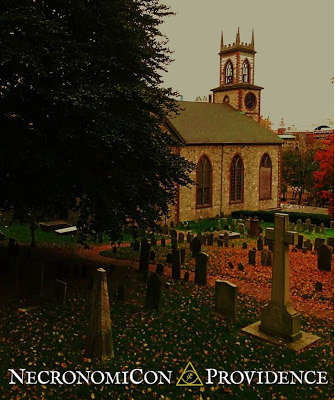
SPONSORSHIPS AND PARTNERSHIPS
NecromoniCon Providence is organized by the Lovecraft Arts and Sciences Council, Inc., a nonprofit organization that dreams of bringing the world-renowned fame of Lovecraft back to its rightful home in Southern New England. We seek business partners, and municipal and state support in order to successfully achieve this dream – a goal with far-reaching benefits. We are presently asking for material resources, venue spaces, financial support, and active involvement from our community. Given the tremendous response we already have, we hope to make this a biennial event. Our hope is to present Providence as a destination city, to that end all the bridges we build now are ones that will make a much stronger future.
The Lovecraft Arts and Sciences Council, Inc. is a non-profit organization based in Providence, Rhode Island. We are a networking center for scholars, authors, and fans exploring the literary world of H.P. Lovecraft and associated authors. We seek to examine the intersection of science and art that lies at the foundation of the H.P. Lovecraft literary genre. We work closely with experts and enthusiasts around the world to foster a critical review of related research, literature, art, and the cultural impact of Lovecraft’s writings on the modern world.
ABOUT THE TEAM
We strive to organize public educational events including NecronomiCon Providence – a biennial convention that explores the work of H.P. Lovecraft and that of his myriad literary and artistic offspring, via speakers, panel discussions, book readings, and workshops. We also organize historic tours, art exhibits, film screenings, plays, and concerts to highlight the world of Lovecraft with a particular emphasis on his home city of Providence – a city that Lovecraft honored and immortalized in the minds of countless individuals around the world.
NecronomiCon Providence is organized by a cabal of close friends and associates with a vision. A horrifying, horrifying vision. Join us in making our nightmares come true.
M. McArtor
Our Graphic Designer Mitch McArtor.
Anthony Teth
Web site of writer, occultist, and oddball, Anthony Teth.
Jay Gidwitz Web Design
The art web site of our web designer Jay Gidwitz.
Arkham Film Society
Josh Gravel and Scott Lefebvre run the Arkham Film Society in Providence, RI.
_________________________________________________________________________
Now, let's take care of some business, and provide you with some updates...
First of all, you have less than FOUR DAYS to kick this (in the words of Anthony Teth) " convention, conference, and celebration of all things Lovecraftian " further up into the cold, uncaring cosmos.
If this great video doesn't load, pounce on the provided link:
From the NecronomiCon Providence 2013 Kickstarter Page :
We're bringing Lovecraft back to Providence! Help us stage the greatest event in his memory ever, with renowned scholars and authors.
Resurrecting the Memory of Lovecraft... just a few more essential salts to go.
Dear Friends - we've been overwhelmed with the amount of support, positive feedback, and buzz we've gotten from Lovecraft scholars and fans, Weird Fiction authors and artists, and all manner of people who have a love for Hoary Providence.
Our plans are rapidly moving forward to bring the world the premier Lovecraft literary and scholarly conference and cultural convention, right here in the heart of Lovecraft's beloved hometown, August 23-25, 2013.
Resurrecting the Memory of Lovecraft... just a few more essential salts to go.
Dear Friends - we've been overwhelmed with the amount of support, positive feedback, and buzz we've gotten from Lovecraft scholars and fans, Weird Fiction authors and artists, and all manner of people who have a love for Hoary Providence.
Our plans are rapidly moving forward to bring the world the premier Lovecraft literary and scholarly conference and cultural convention, right here in the heart of Lovecraft's beloved hometown, August 23-25, 2013.
 STRETCH GOALS
STRETCH GOALS$19,000 - UNLOCKED!!! - We made it!! Now we will be able to have our good friend Jason Eckhardt, a local Lovecraftian artist of great renown, produce a gorgeous brand-new map poster of Lovecraftian sites around Providence and the wider region - absolutely suitable for framing. Given this amazing support, we'll make this available both in pdf form for Download backers to Acolyte backers, and in print for Silver-Key and above backers. THANK YOU!
$23,000 - LOCKED -If we can make it to this level of commitment from all you devotees, we will be able to release an updated version of Jason Eckhardt's superb "Off the Ancient Track" Lovecraft travel chapbook, now long out of print. Given enough support, we'll make this available both in pdf form for Download backers to Acolyte backers, and in print for Silver-Key and above backers.
$25,000 - LOCKED - After much machinating, fulminating, and otherwise plotting and devising some appropriately eldritch rewards for you all... we're still finalizing some of the details, but suffice it to say, this locked level includes a bunch more goodies for all Silver Key and above backers, made by our local and not so local artist friends - limited edition silkscreens of our amazing posters.
For ALL backers above the Acolyte level (i.e. PATRON and BENEFACTOR levels, and above) - a VERY gorgeous limited run amulet made ONLY for all backers above the basic Acolyte level... So, if you're a PATRON or a BENEFACTOR level backer, no matter the theme, you'll get one of these!
And, for ALL full-pass recipients, from PILGRIMAGE on up, you'll get a high-quality embroidered patch of our sigil design, as shown above.
Stay tuned for more (if our febrile minds can conjure more up!).
$60,000 - LOCKED - "We got a badass over here!!!" Wow, we must be nuts for even considering this, but it's been our dream to have Neil deGrasse Tyson come and join us, and give a keynote address explaining how Lovecraft's literary view of the universe is remarkably in line with present cosmology. He is NOT cheap, though, and we simply can't skip other our more pressing immediate convention needs for this extravagance - but, with a little help? Backers at this level (we need four of them, each contributing $9,999 for this to work - fully refunded if it falls through for some reason), will definitely get dinner with the Man, AND absolutely everything else we offer - PLUS, we'll cover YOUR expenses, too - airfare, hotel, and meals! Does that sweeten the pot enough?
Prepare yourselves!
Anoint your feet!
The time for the Pilgrimage is nearly upon us!
__________________________________________________________________________
CALL FOR ABSTRACTS
Seeking new Lovecraft-related research for NecronomiCon Providence, 2013
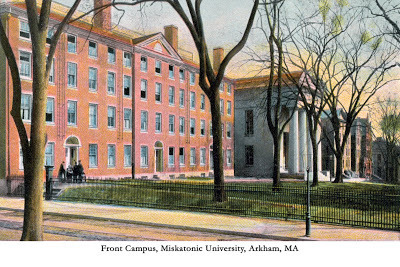 The Lovecraft Arts and Sciences Council, Inc. (the organizer of NecronomiCon Providence) is seeking submissions of academic works that explore all aspects of the works and life of famed weird fiction writer, H.P. Lovecraft, including the influence of history, architecture, science (anthropology, biology, geology, etc), and popular culture (movies, theater, etc), on his works.
The Lovecraft Arts and Sciences Council, Inc. (the organizer of NecronomiCon Providence) is seeking submissions of academic works that explore all aspects of the works and life of famed weird fiction writer, H.P. Lovecraft, including the influence of history, architecture, science (anthropology, biology, geology, etc), and popular culture (movies, theater, etc), on his works.We particularly hope to foster exploration of Lovecraft as a rationalist who created an elaborate cosmic mythology, and how this mythology was influenced by, and has come to influence, numerous other authors and artists before and since. However, all submissions that contribute to a greater understanding of Lovecraft and associated authors and artists of “weird tales” (science fiction, fantasy, horror, etc) are encouraged.
For this component of the Convention, we are particularly interested in soliciting novel work from young or new academics. If selected, presenters should be prepared to deliver a twenty minute oral presentation summarizing their thesis, and are invited to submit a brief MS for possible inclusion in a proceedings publication.
Selected talks will be presented together as part of a mini-conference within the overall convention framework of NecronomiCon Providence, August 23-25, 2013. Interested scholars, whether faculty, graduate, undergraduate, or independent, should send a 250-300 word abstract, preferably in .doc or .pdf format, to [email protected] by May 23, 2013 for consideration.
For more information on our convention, to learn more about the themes to be explored, and to sign up for email updates, please visit our website: necronomicon-providence.com
NB: In addition to these talks, NecronomiCon Providence will also feature numerous traditional panels and presentations given by many of the top names in the Lovecraftian community.
Check this link for further details.
___________________________________________________________________________
Act fast and get in line, kiddies. Don't let this historic event go down without you.
Published on January 04, 2013 18:58
December 28, 2012
TC Book Review & Interview: Richard Gavin Digs Deep into the Nightside in New Collection 'At Fear's Altar' from Hippocampus Press
 Cover art by Harry O. MorrisEveryone wants to stake a claim in both the Big “H” and small “h” Horror game these days. I’m not just talking about writers, but producers, development executives, toy manufacturers, cartoonists, bands, and any other enterprising individuals that utilize (and often exploit) creativity to sell a product.
Cover art by Harry O. MorrisEveryone wants to stake a claim in both the Big “H” and small “h” Horror game these days. I’m not just talking about writers, but producers, development executives, toy manufacturers, cartoonists, bands, and any other enterprising individuals that utilize (and often exploit) creativity to sell a product.Horror is hip. Horror is hot. Horror of a sort, that is... Yet REAL Horror - that which usually graces a sheaf of parchment rather than a played out digital screen - still toils in mainstream obscurity. Quality never sells. Cheeseburgers do. Readers become writers, and writers lower standards to accommodate a wider net cast wide to snare an ever-shrinking pool of actual readers. The wonderful and varied realms of genre fiction – those quasi pigeonholes where Horror is Weird and Weird is Horror - remain cloistered from the outside, yet are increasingly crowded by an influx of burgeoning insiders setting up tents to hock wares and carnival bark. This creates one hell of a party, but it also ultimately sucks the oxygen out of the room. A dry keg, with a line out into the yard of thirsty people gripping tightly their red plastic cups.
Basically, what I’m saying in this clumsy metaphor is that while Horror Fiction once again seems to be growing in popularity (granted, in very small increments), it also is becoming increasingly diluted and marginalized in an attempt to stretch the liquor in the punch as far as it will go. Sooner or later, you can’t taste the bite anymore, and what remains is 15 cans of room temp Hawaiian Punch left to gather fruit flies in the bowl.
Okay, I'll spare you any more fermented metaphors and proclaim this instead: In the realms of Horror, Richard Gavin is the absolute Real Deal, an Occulted acolyte of the numinous and practitioner of the Dark Arts, who is writing some of the best supernatural short stories of our time - hell, of any time. This is the quality stuff that rises above the din, authentic and expansive and true to the fundamental roots of Horror that keeps the genre from teetering into pastiche and fan fic infamy. This is the ethanol in the punch bowl (sorry, last one).
Indeed, I foresee a time in the not to distant future when Gavin joins the Bigs in the annals of supernatural fiction. Not just the living Bigs and those who dreamed and bled to expand the scene throughout the 20th century (Lovecraft, Bradbury, Aickman, Campbell, Klein, Ligotti, etc.), but the venerable Dark Fraternity that traces its history to Poe and Stoker, Mary Shelley, Matthew Lewis, and M.R. James. In the past decade, Gavin has written much, and has much to write, but with this his fourth collection, he deserves a place at the scarred and slowly expanding Table of the Greats, where I can visualize Gavin sitting with the old and moldering Weirdists, sharing a glass of port by candlelight and not seeming out of place in the slightest. He lives for this pursuit, this searching The Dark, and it shows in every finely craft line and new vista he documents.
As a colleague of mine (his name rhymes with “Simon Strantzas”) recently stated in a conversation, At Fear’s Altar is “an important collection,” and I heartily agree. This book has a solidness to it, a largeness and import that is undeniable. Upon first reading - and I imagine upon second and third - his stories quickened my pulse, shook the cobwebs from my psyche and made me sit up a little straighter as my eyes shot across the page. When forced to set the book aside by the vagaries of daily schedule, scenes stayed with me like a slow burn, which I find to be rare phenomenon these days, as it is not often that the written word produces such a lasting, internal reaction. His stories are alchemical, creating something new inside you born out of unrelated parts, leaving fresh elements in their wake that hadn't previously existed in this reality.
Stylistically, he is clean and confident, imbuing the thirteen tales that make up At Fear’s Altar with a music that is comfortingly classic in language and theme, yet totally fresh in execution. And his work is often legitimately scary, which is another rarity. I think this stems from the fact that Gavin seems like an authentic article when it comes to Horror. I don’t pretend to know him well, but of what I do know of the man, his writing (both fiction and non), his scholarship, and general intellectual pursuits, paint the portrait of an individual who doesn’t wear the trappings of horror as a pose. Instead, the True Dark seems to emanate from his DNA. He is Occulted in a consummate way that isn’t some religious (or lack thereof) commentary or rebellion against the Light, but that of an enthusiastic Seeker truly inspired by and deferential to matters of esoterica, from earthy black magic to the unknowable secrets of cold cosmicism.
And you can taste it in At Fear’s Altar. It all sounds close by, and in some cases improbably true, which makes it all the more frightening. Gavin is not just trying to set trite stories in "spooky" places. He explores the full palette of dimensional reality and possibility, weaving in nods to the Outer Abyss, Hell, and unnamed places in between, including those just down the street, or perhaps just over the hill. Everywhere is his playground, everything his swing set, which makes his stories so widely appealing. Lovecraftians, Supernaturalists, Hellhounds, and fans of the Uncanny will all find something to enjoy in At Fear's Altar, if not celebrate.
The collection begins with a Prologue titled "A Gate of Nerves," which sets the table for what is to come, evoking an atmosphere of the supernatural and the unfolding encomium to fear in all of its forms and guises, and ultimately effects. The tales that follow range from very good to extraordinary, but I'd like to focus on several that I found to be particularly splendid.
“The Abject” recalls a Laird Barron tale, or maybe Simon Strantzas. Or perhaps Laird Strantzas. A healthy dose of cosmic horror and wilderness terror, interwoven with relationship decay, that leads to a tragic end without easy explanation. There are topographical similarities between "The Abject" and "Annexation" (strange outcroppings of land just off shore), although the latter deals with a mother searching our her son lost to dark teachings, leading her to a conclusion of which she was better served to remain ignorant.
"A Pallid Devil, Bearing Cypress" seems as early 20's century and European as its setting. Just a fantastic tale emerging from a bombed-out city suffering under a constant Nazi Blitzkrieg that shows Gavin's deftness with matters more demonic than straight up cosmic. "Darksome Leaves" is a fully modern, Ligottian tale, and plays with item horror and masks as keys to something far deeper and infinitely powerful. "The Plain" is a Weird Western combined with a morality tale as old as the desert, that recalls Robert E. Howard, with a more elegant touch.
“Faint Baying from Afar,” which is “An Epistolary Trail after H.P. Lovecraft’s ‘The Hound’” is a nod to one of Gavin's influences, and the noted epistolary style brings out Gavin' classic chops. This is an elegant tale, told through letters from a son to his mother, which only makes the growing horror all that more unsettling. Another bow to Lovecraft is "The Unbound," which to me, honors writers even further back, including Bierce, Blackwood, and Machen.
Personally, I found "Chapel in the Reeds” and “The Eldritch Faith” - the stories that bookend the collection - to be not only the strongest pieces in At Fear's Altar, but truly some of the best Weird fiction stories I've ever read. The way Gavin handles the fears and uncertainty of old age in "Chapel in the Reeds" is so impressive that I would have sworn it was written by an octogenarian. From the POV of a man struggling to hold on to his sanity, memory, and what is left of his family eroded by natural causes, Gavin folds in the additional threat of a strange, tiny church secreted away in the woods, which is the perfect device to terrify and mystify both reader and protagonist. Unsettling and though provoking, to be sure, and an excellent rumination on the ravages of old age.
"The Eldtritch Faith" is quite simply an achievement, a symphony that includes all of the instruments that make up the settings and textures of the best modern supernatural/Weird fiction. I love this story the way I love "The Shadow Over Innsmouth," "The Great God Pan," "The Events at Poroth Farm," or "The House on the Borderland." It's intimate, yet huge; fantastical, yet somehow seems rooted in a reality that very few of us know to be true, but of which all of us have an inkling, as the story begins with a boy looking for the presence that he knows lives in his basement, and ends up in places he - nor I - ever dared dream existed. This is revelatory cosmic horror underpinned by the occult of our earthly traditions and limitations. If someone told me they were curious about modern Weird fiction, and asked for suggestions, "The Eldritch Faith" would be on a very short and distinguished list. As such, this novella ends the collection with a limitless bang, and sets up Gavin's next work as an absolute must-have.
At Fear's Altar - and Richard Gavin, as a fictionist, essayist, and general figure - is what Horror needs, if the forces of true creativity and innovation are going to battle back those armies amassed to exploit cheap parlor tricks, reconstituted dreck barely resembling the original article, and sparkly spook pap churned out to appeal to the widest and least interested portion of our population. This collection has the power and vision to recapture the numinous and keep the steam train on the iron track, to bring respectability back to the genre, to keep the "H" big and proud. If you're as goddamn hungry as I am, punt the cheeseburgers and pick up some Gavin. Straight, no chaser. Nothing watered down, boasting a full array of flavors resting on the tongue, waiting to be unlocked by the discriminating and tasteful. The burning fluid in the glass that warms the gullet and fires the synapses, turning the mind to thoughts of the infinite and beautifully dark.
___________________________________________________________________________
Instead of cursing me for subjecting you to yet another liquor metaphor (and two respective mentions of cheeseburgers), please instead scroll down a bit and dig into the discussion conducted with Richard Gavin in this fourth installment of The Cosmicomicon Book Review & Interview (the preceding three being Strantzas, Barron, and Cardin), which explores his views on supernatural fiction, his dream realized of working with S. T. Joshi, and his overall take on Horror and the unquiet Beyond that goes far beyond just story writing.
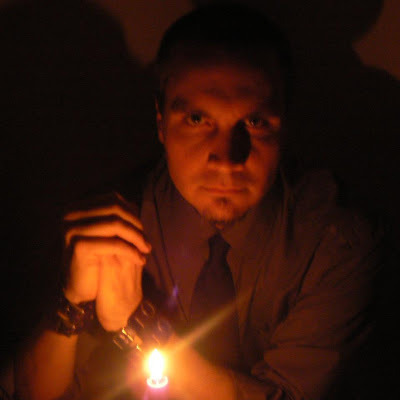
TC: Allow me to softball the beginning, and to establish some background after grasping about in the dark above… You dedicate At Fear’s Altar to Clive Barker and Algernon Blackwood. Aside from these two gents – or possibly including these two gents, depending on where you want to go - who are your biggest literary influences?
RG: Barker and Blackwood are definitely among my deepest and most enduring influences. In Blackwood I found an honest writer. His work encouraged me to speak of ineffable Nature as beautiful and terrifying at once, and to express my own reflections on the universe regardless of how these visions may clash with those of the culture and age in which I live.
Clive Barker was the writer I most wanted to be as a young man. The Books of Blood and The Hellbound Heart absolutely shattered my notions of what modern supernatural fiction could do. The eloquence of the prose, the almost religious heft of the images, the courage to push the envelope past the cozy campfire story model that other bestseller authors were producing, not to mention the genuine Artist’s conviction that Clive always demonstrates in interviews…these are just a few of the reasons behind At Fear’s Altar’s dedication.
Along with these writers I would say that my work is supported by three distinct but equally important pillars of influence:
The first will be obvious; the visionary Horror authors such as the two gents listed above, along with Lovecraft, Maupassant, Machen, Poe, M.R. James, T.E.D. Klein, Laird Barron, etc.
The second school is that of the realists. I’m a great admirer of Raymond Carver, Dorothy Parker, Eugene O’Neill, Flannery O’Connor; the authors who present small lives, very human stories, with photographic clarity. I openly admit that the supernatural authors have a much more potent influence simply because the realists, while offering great characters and tremendous prose, often lack what Arthur Machen called “the ecstasy of literature.” I need my work to resound from the depths of the human condition, to echo the outer dark.
The third influence stems from esoterica. The bulk of my library is occult books and many of these authors and practitioners --- Kenneth Grant, Austin Osman Spare, David Beth, etc. --- have enhanced my life experiences, which has resulted in, I think, supernatural fiction that is textured rather differently than the work of many of my peers.
TC: In the same literary legends vein, I know you were personally saddened by the passing of Ray Bradbury this past year. What did his work mean to you?
RG: Bradbury was, like Blackwood, a very pure writer. What always resonated with me about his work was that he never presented the Gothic as ugly or repulsive. He wrote paeans to the dark. There are a number of Horror writers who erroneously equate Horror with the belief that life is ugly and endlessly agonizing. Their work is a pushing of the reader’s face into a steaming pile of offal. Bradbury was the opposite. His work says “Graveyards are beautiful. Skeletons are magical. Being scared is a good thing...”
Interestingly enough, at first glance one might assume that my novella “The Eldrtich Faith” is a Lovecraft pastiche because of its title, but many elements of that piece are steeped in Bradbury. I consider it a kind of parting letter to one of my lifelong favourite authors.
TC: Your stories have a comforting classicism to them, yet still breach previously uncharted boundaries. Is your writing in some small way a conscious nod to those writers who came before you, or is it just the purely unconscious outpouring of your organic creative Muse?
RG: At this point I think the process is organic. The influence of the classic Horror writers is by now so distilled in my psyche that I don’t even notice it anymore.
But you are correct: I always want to push into uncharted boundaries. That’s crucial for me. One of the reasons I prefer being identified as simply a Horror writer instead of a writer of strange stories or what have you is that I don’t want the reader to assume I’ll be handling their psyche with kid gloves. I will never stoop to exploitation, but at the same time I make no promises about what kind of Horror my work will deliver. I’m forever pushing into new territory, conjuring what I hope are even more outré images and disquieting situations.
In some ways my creative drive can be summarized by a lyric from my favourite band, Tool: “I’m reaching for the random or whatever will bewilder me. And following our will and wind, we may just go where no one’s been.”
I want to push my work to the horizon, and then keep going. This has done me a fair bit of harm, professionally speaking. I’ll wager I have more rejection slips that read “We have no real criticisms, we just don’t know what to do with this story” than any other writer I know. My work was too weird, too deadpan, and too “cosmic,” I suppose, for most of the modern Horror magazines. But it was also far, FAR too hardcore for the more traditional ghost story journals. So for many years I was adrift with hardly any venues that were willing to publish me.
TC: In this world of uneasy Amazon compartmentalization, how do you define yourself as a writer? You obviously revel in cosmic horror, and honor H.P. Lovecraft specifically in your tale “Faint Baying From Afar” (a sequel to HPL’s “The Hound”). Do you consider yourself a Lovecraftian writer? Has this ever-expanding label lost some of its luster with the glut of Mythos tales being written; and further, has that possibly become a stigma lately with more emphasis on his personally held views on race and other political and social issues that have been bandied about lately by other horror writers?
RG: I usually identify myself as simply an author of supernatural Horror. That being said, I have seen the adjective “Lovecraftian” attached to my name more often than not, and it is a title I am very proud to bear. My only reservation with it is that it can be misleading to readers who come to my work expecting Cthulhu, etc. I have written stories that are overtly placed in Lovecraft’s universe (two examples can be found in At Fear’s Altar), but more often than not I’m attempting to reach that level of awe that Lovecraft himself strove for, but in my own way.
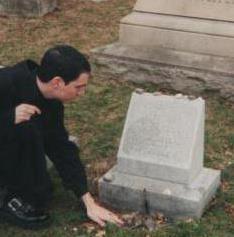 Gavin at HPL's grave in Swan Point (2002)In my ‘teens I was utterly obsessed with H.P. Lovecraft. He remains a perennial favourite and a source of inspiration. This is part of the reason why working with S.T. Joshi continues to be such a surreal and rewarding experience. (More on this later.) So if we are talking about Lovecraft’s love for the ancient and ineffable, his passion for the weird and sinister affects of literature, his devotion to atmosphere and place, and his belief that supernatural Horror should have philosophical heft, then yes, I absolutely consider myself a Lovecraftian writer.
Gavin at HPL's grave in Swan Point (2002)In my ‘teens I was utterly obsessed with H.P. Lovecraft. He remains a perennial favourite and a source of inspiration. This is part of the reason why working with S.T. Joshi continues to be such a surreal and rewarding experience. (More on this later.) So if we are talking about Lovecraft’s love for the ancient and ineffable, his passion for the weird and sinister affects of literature, his devotion to atmosphere and place, and his belief that supernatural Horror should have philosophical heft, then yes, I absolutely consider myself a Lovecraftian writer. As far as Lovecraft’s racism goes, this is old news to anyone who has even a casual knowledge of HPL’s biography. I don’t share Lovecraft’s views on race, though I do resonate with his suspicion of and/or disdain toward humanity’s reflexive belief in “progress.” Like Lovecraft, I can never be tied to raw new things.
Bashing Lovecraft as a xenophobic hack has become the hip thing to do on social networks and at conventions. While I’m not going to stop anyone from voicing their opinion, I will say that I’ve yet to see any of these detractors produce a cosmic tale that equals “The Colour Out of Space” or At the Mountains of Madness. Like it or not, HPL is a monument in the genre and that won’t ever change.
TC: As noted in my review above, I consider you an authentically Occulted Writer, as your understanding and gleeful embrace of the True Dark is unmistakable. What elements of your background and/or research have equipped you to write the stories that you create, which – for my money – are more rooted in the wider supernatural tradition?
RG: Thank you for this question, Ted. I’ll do my best to answer it as succinctly as I can. Let the reader embrace or dismiss this as they will...
My stories may exhibit a deeper knowledge of that “True Dark” you mention, but of course that doesn’t make them better than anyone else’s stories. Nor does it make me a smarter writer. If there is uniqueness or an uncanny “heft” to my work, it is likely because my interest in this area is not academic. I live much of my life within that True Dark. What’s more, I wouldn’t have it any other way.
I believe that the darkness, or the “Nightside” to use Kenneth Grant’s term, takes us to the horizon of our own knowledge, to the limits of our own experiences, and then introduces something Other, something from the shadows beyond our preconceived reality model. For some people just being brought to this personal horizon is strong enough meat. Others like me want to go beyond.
A careful reading of my work will reveal a variety of stories where the characters wish to know the monster, to experience the monster, and in some cases to become the monster. There is a primordial urge there. I’m not wagging my finger against the oozing primitivism the way M.R. James was. I’m pushing my characters, and by extension my readers, off the cliff’s edge and into the abyss. I want immersion, a sense of limitlessness.
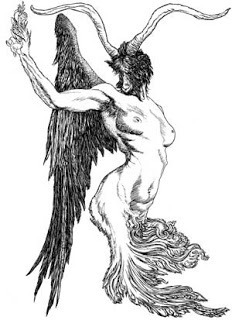 One of my greatest inspirations is the British artist and occultist Austin Osman Spare. Many of his incredible drawings were created while he was in an altered state of consciousness. They were automatic drawings wherein he would rarely lift his pencil from the page, allowing the Spirits to guide his hand.
One of my greatest inspirations is the British artist and occultist Austin Osman Spare. Many of his incredible drawings were created while he was in an altered state of consciousness. They were automatic drawings wherein he would rarely lift his pencil from the page, allowing the Spirits to guide his hand.He believed, as do I, that works of art created under auspicious conditions act as “vessels.” They do more than present images; they convey the energies that informed those images. It is these energies (not the metaphor or image) that an audience responds to. The image is important because it is the vehicle that carries the essence, but there is always something behind true Image. This makes that magical bond of spirit to spirit, Muse to artist, artist to audience. It is a transference.
The energies that inform dark art can inspire an atavistic awakening. The best Horror plunges its claws right through the thin ice of logic and stirs up the cold dark waters of our subconscious. This is partly why one feels so alive when one is frightened by a supernatural piece. Whether ghosts or Yog-Sothoth or werewolves are physically “real” or not is completely redundant. One does not need to come away from any of my tales “believing in” the events they just read about. But hopefully they come away knowing something about the energies that churn beyond my images. Hopefully they experienced the cold touch of the ghost inside the machine, so to speak.
Spare used images and I use words. But in the end our art serves as a catalyst that allows its audience to enter an altered state just by experiencing the work. I relish the idea of stirring ancient feelings in modern readers, of rousing a sense that they are not a mere cog in some tidy civilization wherein all things are quantified and pat, but are instead part of a vast and haunted wilderness. My aim is to deliver primordial experiences.
My stories do not serve any particular spiritual tradition or religion per se. They are designed as shamanic tools that I hope will awaken the reader to his or her self. I’m not preaching any specific worldview. I want people to wake up to themselves, to realize the dark in their own way.
For me as the author, the tales are expressions of a larger, lifelong quest to explore the Nightside. They are footnotes to those moments when I have found my own horizons, found what Horrified me. My life is a continuous meditation within this True Dark.
This should explain why I’ve no interest in “branching out” into other genres. My tales are more than a literary construct to me. They are ligatures that connect me with the dark continuum that has been churning since primitive man first painted grotesques on the walls of Trois-Frères cave in France, if not earlier.
All this being said, I must stress that if someone reads my work simply to be creeped out for a few minutes, that is perfectly valid and is also flattering to me. If a shudder is experienced, I have done my job. One doesn’t need a working knowledge of occult practices in order to enjoy my work. I design the stories to be inclusive, not exclusive. My work is for all. The key is to FEEL something!
TC: Following on that, is what you write best classified “Horror,” or do you place it someplace else? Is there a need for subsets apart from just simply Horror?
RG: “Supernatural” would be the only qualifier I would add, simply because all my stories possess one otherworldly element or another, but Horror suits the work just fine. I love this genre.
TC: What is your take on the contemporary Speculative Fiction industry, and where do you want it to go, as a reader and a writer?
RG: I confess to having a love/hate relationship with the Speculative Fiction industry. The love angle comes from having a lot of friends in the field who are smart, talented, and fascinating. It’s a very supportive realm. And of course I love the process of writing and working with skilled editors. All of these elements inspire me.
The hate element stems from my innate disdain for those who wish to live in a bubble. SpecFic and “fandom” fosters a phony alternate universe wherein people can drift from convention to convention, crawling up ever-further into their own heads.
This is anathema to me. The writers I value most are ones who write of this world, not of a pale metaphoric Middle Earth or a land beyond the Wardrobe, but a world in which we can/should be fully present. From Lovecraft’s vast cosmos to Machen’s haunted hills to Blackwood’s sentient woodlands to the submerged primitivism of M.R. James; these stories are about awareness, not escapism.
TC: How long did it take you to write and assemble At Fear’s Altar? How many stories did you complete before settling on the thirteen that made it into the collection, and how much rewriting did you do once you had chosen the stories?
RG: The book took me about eighteen months to write. I omitted three stories and then S.T. and I agreed to replace one tale in the book with another. Most of the rewriting occurred before I submitted the manuscript to S.T., simply because I was terrified of disappointing him! S.T. then did some revisions with me and, unsurprisingly, all his suggestions vastly improved the tales.
TC: The inimitable S. T. Joshi wrote the forward to At Fear’s Altar. How did you hook up with Hippocampus, and arrive on Mr. Joshi’s creative radar (if, in fact, the two occurrences are unrelated)?
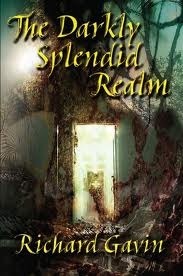 RG: I’d been a fan of S.T.’s since I began collecting the Arkham House collections of Lovecraft that he edited. I followed his column in
Weird Tales
and therefore knew he was a stern critic of supernatural literature. For years I actively avoided sending any of my work his way for fear of what he might say about it. Finally in 2009, after Dark Regions Press published my third collection,
The Darkly Splendid Realm
, I mustered up my courage and emailed S.T. to introduce myself and politely inquire if he might be interested in a copy of my book.
RG: I’d been a fan of S.T.’s since I began collecting the Arkham House collections of Lovecraft that he edited. I followed his column in
Weird Tales
and therefore knew he was a stern critic of supernatural literature. For years I actively avoided sending any of my work his way for fear of what he might say about it. Finally in 2009, after Dark Regions Press published my third collection,
The Darkly Splendid Realm
, I mustered up my courage and emailed S.T. to introduce myself and politely inquire if he might be interested in a copy of my book.Imagine my shock and delight when S.T. informed me that he was already familiar with my work. I sent him the new collection and a few weeks later S.T. invited me to submit to his anthology Black Wings II . His acceptance of my story “The Abject” was marvelously enthusiastic. In early 2011 I decided to roll the proverbial dice by asking S.T. if he’d be interested in considering my next collection as a Hippocampus Press title. He (provisionally) accepted the book sight-unseen.
Working with S.T. on this and other future anthology projects is an immense honour. All I’d wanted to do with my career is create stories that might be considered contemporary additions to the linage of the great weird tale writers of the past. Being taken in as a kind of protégée of S.T. Joshi’s has certainly felt like a fulfillment of this goal.
TC: This is your fourth collection. Do you find writing becoming easier?
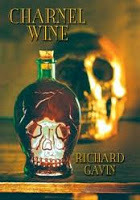
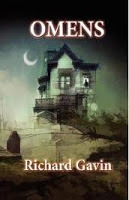 RG: No. If anything it’s more difficult now. I’m much harsher on the stories, setting increasingly higher demands on myself. I keep going because I want to convey visions of even greater intensity and awe, to deliver prose that is ever-smoother and more potent.
RG: No. If anything it’s more difficult now. I’m much harsher on the stories, setting increasingly higher demands on myself. I keep going because I want to convey visions of even greater intensity and awe, to deliver prose that is ever-smoother and more potent.TC: Based on the book’s title, and after discovering and reading the collection prologue “A Gate of Nerves,” I was expecting each tale that followed to be a tribute to fear. I think I was chasing black rabbits, looking for something that wasn’t intentional. Am I off here? And if so, what was the purpose of the seemingly open-ended prologue?
RG: “A Gate of Nerves” was employed to place the reader in a particular headspace. The prologue is rooted in the Hyakumonogatari Kaidankai, which was a Japanese Buddhist practice that later became a kind of parlour game wherein participants would tell ghost stories and blow out candles one by one. The intention was to “invoke” a spirit or entity that would reveal itself after the final candle was extinguished. The reason I referenced this particular ritual was to alert readers to the fact that supernatural tales have been, and can be, used for something more meaningful than whiling away a few moments. They create thickened atmospheres where our surroundings suddenly feel sentient.
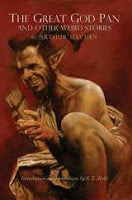 Once that gate of nerves parted, the rest of the stories exhibited different ways that fear can rebirth us. We might not always like what we are being awoken to, but our awareness is sharpened all the same.
Once that gate of nerves parted, the rest of the stories exhibited different ways that fear can rebirth us. We might not always like what we are being awoken to, but our awareness is sharpened all the same. The reason why fear was not “celebrated” in an overt way is because fear (or more accurately, Horror) is best evoked rather than dissected. It is not an academic principle. We can analyze it, discuss it, theorize why it is we are or are not drawn to it, but in the end it is a force that erupts in spontaneous ways. The ancients called this startlingly immediate and untrammeled awareness of the Now “glimpsing the great god Pan.” In this sense, all of my stories are invocations of the great god Pan.
TC: Amongst the many extraordinary stories in At Fear’s Altar, “The Eldritch Faith” somehow stands out as a true achievement. This is a harrowing, intimate, yet gargantuan tale, incorporating both cosmic horror and more material supernatural elements. Where did this story come from, and how much of the protagonist in “The Eldritch Faith” is based on you as a young boy?
RG: Thank you for your compliments. I confess that “The Eldritch Faith” is my favourite piece I’ve written.
The story stemmed from my wish to create something as panoramic as Comte de Lautremont’s Le Chants de Maldoror , and yet something that was also intensely intimate. The novella reads like a house of cards; each chapter building a very delicate piece of a pattern rather than a linear narrative.
In terms of the autobiographical content, I’m sure there’s more there than even I realize. I was blessed with a happy childhood, but I was certainly a weird kid. I really reached back to try and capture the feeling of playing imaginative games in my own basement as a boy. I also wanted to convey the sense that childhood is a very magical time where we have not compartmentalized reality. We exist in a strange, almost non-dualist state of being. We lose that as we mature.
TC: You deal with some explicit themes on occasion, but you rarely, if ever, use coarse/explicit language, and sexual imagery is described in an almost archaic, modest way. This was striking to me in a genre that often “works blue,” at best, and at times seems to relish in the perverse and graphic. Is your delicate dealing with such situations intentional, or a natural outgrowth of something more natural?
RG: It’s definitely intentional. When I’m writing a story where the aim is to instill in the reader a sense of awe or feelings of disquiet or what have you, I need to be careful that nothing steals the thunder of that intended purpose. Sex and violence are the screeching, clattering tools in a writer’s toolbox. Go ahead and employ them, but be aware that those may be the only elements a reader takes from your tale if you’re not careful.
Sex has been included in a lot of my stories actually and it will continue to be. It’s one of the great primal-level mysteries or drives that I like broaching. I’d rather have a sex-heavy story than a violent story.
I try to use violence as sparingly as possible. It’s too easy and too often tasteless. Everyone’s scared of being physically brutalized. They don’t need constant reminders of this fact. I’d rather attempt to stir a sense of the numinous or the ghostly instead of churning the reader’s stomach.
TC: By all accounts, you’ve made your bones exclusively as a short fiction writer, yet the refrain of “the novel is king” pervades the entire literary industry, regardless of genre, and I’m guessing it echoes in the mind of every short fiction author. What is your take on the widely held notion that a modern writer of fiction must produce a novel to truly achieve success, creatively or commercially?
RG: Karl Edward Wagner once wrote about a survey that was conducted in the 1970s in which publishers looked at who in the United States were the biggest book consumers. They determined that commuters in New York City was their biggest demographic. These commuters were polled about what types of books they like to read. The majority of them preferred novels. Thus, New York mass market publishing houses turned their focus to novels, at the expense of almost every other kind of book. This should give people an idea of how solid a foundation the “novel is king” worldview stands upon: a forty-year-old demographic survey designed to maximize a quick buck for publishers of potboilers.
To be honest, I don’t know what level of “success” writers can even achieve anymore. The days of “The Lottery” causing a cultural tempest are long gone. I don’t know if our contemporary culture values authors the way it once did. So when I see authors jumping through hoops in the hopes of “getting discovered” I feel nauseous. It’s truly pathetic. The only success a writer can have is to write fully of themselves and for themselves. Everything else is fleeting.
TC: We are both contributors to Matt Cardin’s The Teeming Brain, the megasite devoted to the discussion of consciousness, horror, philosophy, religion, and other esoteric elements that bridge and imbue the Dark. What do you enjoy about non-fiction writing, and what can readers look for in upcoming installments of your column “Echoes from Hades”?
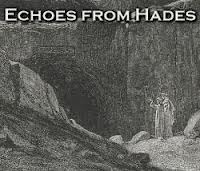 RG: Writing non-fiction allows me to explore themes more directly than I can in fiction. You can look forward to my essay explaining how I believe that all my fiction is, in a sense, heartfelt invocations of the great god Pan.
RG: Writing non-fiction allows me to explore themes more directly than I can in fiction. You can look forward to my essay explaining how I believe that all my fiction is, in a sense, heartfelt invocations of the great god Pan.TC: Richard Gavin. Simon Strantzas. Ian Rogers. Gemma Files. Gord Rollo. John R. Little. Michael Kelly. Monica Kuebler. Brett Savory. Sandra Kasturi. Helen Marshall. Nancy Kilpatrick. Kelley Armstrong. Douglas E. Wright… A Canuck murder’s row. Canada has stormed into the Weird and Horror Fiction game lo the last decade, from writing to publishing. What did they dump in the mountain spring water of the Great White North that has produced such an uptick in outstanding Dark Fiction writers since the dawning of the 21st century? Is the home of comedy becoming the new home for Speculative Fiction?
RG: I wish I knew. I love living in Canada. No country is perfect of course, but Canadians have little to complain about. We have free healthcare, a high standard of living, little violent crime, and (for the most part) a very relaxed atmosphere. Canada is also a vast country with a small population spread across vastly differing terrains. We are geographic neighbours with the U.S. but have more ties with the Brits. We’re kind of culturally adrift in this respect.
So perhaps all these elements all combine to make Canadian dark fiction unique, the same way that Finnish or South African or Russian speculative fiction would be.
TC: What’s next for you on the writing front, and what are you looking forward to in 2013?
RG: I am working on another book. But I’m a painstaking writer, so I have no idea when it will be ready.
Next year I’m looking forward to the new collections by Nathan Ballingrud, Matt Cardin, and John Langan. I’m also excited about NecronomiCon, the Lovecraftian convention happening in Providence in August.
TC: Thank you very much, Richard, for spending your valuable time sharing with the readers of The Cosmicomicon. Allow me to wish you a healthy, happy, and hugely productive New Year.
RG: Thank you, Ted. It’s been a pleasure. All the best to you and yours.
_________________________________________________________________________
Do yourself a favor - get more Gavin, starting with At Fear's Altar and working backwards, with The Darkly Splendid Realm , Omens , and Charnel Wine . Any serious reader of contemporary WeirdFic and Supernatural Horror must have these tomes on their shelves.
Richard Gavin is The Cosmicomicon approved. Far more importantly, he's S. T. Joshi approved. And that, my friends, is saying something.

Published on December 28, 2012 15:09
December 5, 2012
Come Play in Punktown: Miskatonic River Press Adapts the Famed CyberCraft Horror World of Jeffrey Thomas into New Role-Playing Game
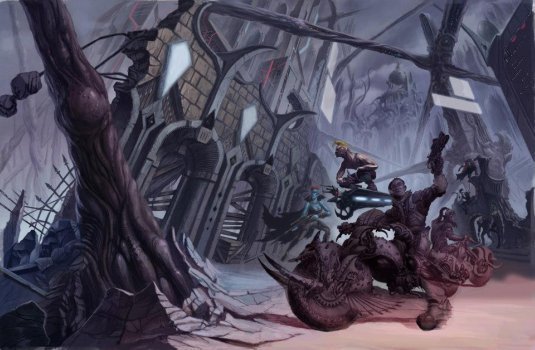 Punktown RPG cover art by Mariusz GandzelOne of the exciting powers wielded by writers of fantastical fiction is the atoms-up creation of worlds insider their minds - actualizing "real estate," as I call it, usually when grumbling that the story I am working on has too much of it, which makes the fabricating of each square foot all the more time consuming. Those writers who set their tales in modern, contemporary, and/or familiar settings don't need to constitute much real estate at all, as it has already been shaped and realized by that helpful imp called Reality. Even Lovecraftian writers aren't burdened with carving much ariable land out of the wilderness, as a slightly built man from Providence - and many of his inspired disciples - have done much of the heavy lifting for us.
Punktown RPG cover art by Mariusz GandzelOne of the exciting powers wielded by writers of fantastical fiction is the atoms-up creation of worlds insider their minds - actualizing "real estate," as I call it, usually when grumbling that the story I am working on has too much of it, which makes the fabricating of each square foot all the more time consuming. Those writers who set their tales in modern, contemporary, and/or familiar settings don't need to constitute much real estate at all, as it has already been shaped and realized by that helpful imp called Reality. Even Lovecraftian writers aren't burdened with carving much ariable land out of the wilderness, as a slightly built man from Providence - and many of his inspired disciples - have done much of the heavy lifting for us.But those who peer into the blackness, wave their magic quill, and bring navigable conjure real estate from the formless void are doing real, strenuous work, which also carries with it a high threshold for reward. Being a Creator of Place gives the scribe total control over the physics, laws, and makeup of everything inside that new sphere of metaphysical existence. They are God of this Place, and that is heady stuff.
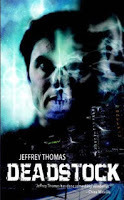 Renowned author (and one of my favorite living horror writers) Jeffrey Thomas has played God, and birthed forth a dark, dangerous place of neverending possibility and infinite pain called Punktown. To crib his official bio, Thomas is a prolific writer of science fiction and horror, best known for his stories set in the nightmarish future city called Punktown, such as the novel Deadstock (Solaris Books) and the collection Punktown (Ministry of Whimsy Press), from which a story was reprinted in St. Martin's The Year's Best Fantasy and Horror #14. He has been a finalist for the Bram Stoker Award (Best First Novel) for
Monstrocity
, and a finalist for the John W. Campbell Award for Deadstock.
Renowned author (and one of my favorite living horror writers) Jeffrey Thomas has played God, and birthed forth a dark, dangerous place of neverending possibility and infinite pain called Punktown. To crib his official bio, Thomas is a prolific writer of science fiction and horror, best known for his stories set in the nightmarish future city called Punktown, such as the novel Deadstock (Solaris Books) and the collection Punktown (Ministry of Whimsy Press), from which a story was reprinted in St. Martin's The Year's Best Fantasy and Horror #14. He has been a finalist for the Bram Stoker Award (Best First Novel) for
Monstrocity
, and a finalist for the John W. Campbell Award for Deadstock.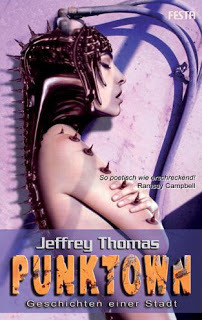 For decades, Thomas has penned novels and short stories of futuristic horror set in the far flung megalopolis Punktown, amassing a history tome filled with dread and cover-wrapped in blood, splayed out under a cold cosmos populated by Elder Gods and chugging space freighters. Punktown is a Weird fiction classic, and now - thanks to the inspired minds at Miskatonic River Press - you, dear reader, have been invited to walk the dingy streets, mix amongst the indigenous Chooms, hard scrabble human immigrants, and a murderous mix of alien races, mutants, clones, and sentient machines. This is Lovecraftian Cyberpunk (or CyberCraft, as I call it ). This is Sci-Fi Noir. This is the real estate of Punktown, and now you're allowed inside, to do as you will, and certainly as you must.
For decades, Thomas has penned novels and short stories of futuristic horror set in the far flung megalopolis Punktown, amassing a history tome filled with dread and cover-wrapped in blood, splayed out under a cold cosmos populated by Elder Gods and chugging space freighters. Punktown is a Weird fiction classic, and now - thanks to the inspired minds at Miskatonic River Press - you, dear reader, have been invited to walk the dingy streets, mix amongst the indigenous Chooms, hard scrabble human immigrants, and a murderous mix of alien races, mutants, clones, and sentient machines. This is Lovecraftian Cyberpunk (or CyberCraft, as I call it ). This is Sci-Fi Noir. This is the real estate of Punktown, and now you're allowed inside, to do as you will, and certainly as you must.Indeed, Punktown is now set to roll out as a Role-Playing Game. Now, it can be your turn to play God, making note to mind your Elders, by picking up Punktown: An RPG Setting for Call of Cthulhu and BRP .
Miskatonic River Press, in their infinite wisdom, recently selected Thomas' Punktown universe as one of their newest settings, writing Punktown: An RPG Setting for Call of Cthulhu and BRP for the famed BRP system, allowing Call of Cthulhu players and keepers to play in Punktown, as the game was created to be completely and seamlessly compatible with Call of Cthulhu and Chaosium's many other game settings.
A Kickstarter is up and running to help fund this fantastic project. Fans of RPGs, CoC, and of Jeffrey's Thomas' exceptional fiction can click here and pledge a little to make this happen. Much like NPR and Public Television, you need to pay a little up front to get the good stuff in the end. You've gotta' back what you love. This is no different. Funding this project via Kickstarter will cast a ballot for quality, and bring a new CyberCraft world into the gaming universe.
To provide a bit of context and background on the project, we may as well go straight to the horrorist's mouth, so to speak. For those who missed it, Thomas answers all the questions you might have in his recent addition to the winding cybersnake The Next Big Thing, published last week on his Punktalk (Confessions of a Punktowner) website:
(1) What is the working title of your next book?
Right now the publisher, Miskatonic River Press, is calling it: Punktown: An RPG Setting for Call of Cthulhu® and BRP. Because that just about says it right there. The book will a role-playing game guide based on my dark future world of Punktown, which is the setting of many of my novels and short stories. The game will be compatible with the Call of Cthulhu® and BRP systems.
(2) Where did the idea come from for the book?
It was suggested to me by Michael Tresca — author of the nonfiction book The Evolution of Fantasy Role-Playing Games and the novel The Well of Stars, among others — that my milieu of Punktown would make a great setting for a role-playing game. He started constructing a set of “core rules” based on his extensive reading of my Punktown material, devoting chapters to game mastering, character types, powers, weapons and technology, aliens and creatures, etc. All the aspects of Punktown that make my stories set there so varied: now at a gamer’s disposal. Once we had these core rules to present, Mike took them to Tom Lynch, president of Miskatonic River Press, and Tom was sold on the project. Tom then invited writers Brian M. Sammons and Glynn Barrass onboard, based on their experience with gaming and their enthusiasm for Lovecraft’s Cthulhu Mythos, to write game scenarios for the book.
(3) What genre does your book fall under?
My Punktown stories are a fusion of science fiction, horror, noir, pretty much any genre or subgenre that strikes my fancy. They’ve been variously described as cyberpunk and New Weird, but when I write one I don’t think in terms of genre…I’m just going to take another trip to Punktown. And incidentally, I’ve always written each Punktown story — whether short story or novel — so that it could exist on its own, without a reader having to catch up on any other Punktown story first. I’ve even utilized the Cthulhu Mythos in some of my Punktown stories, most notably in my novels Deadstock and Monstrocity, so gamers are going to be able to play Call of Cthulhu® -type scenarios in a refreshing new setting…a dystopian far future setting. But they can also leave the Mythos out entirely if they’d rather. The possibilities — and dangers — in the city of Punktown are endless.
(4) What actors would you choose to play the part of your characters in a movie rendition?
Besides having inspired the game’s setting and monitoring all material to make sure it’s consistent with the Punktown universe, my own contribution to the book is two original short stories…included as an introduction to the game’s world through the creator’s eyes. It’s hard for me to imagine who might play the characters from those stories — particularly since one story’s protagonist is Jeremy Stake, the private eye hero of my novels Deadstock and Blue War. Stake is a mutant with the ability to change his appearance at will (and sometimes even against his will). In his natural state, he has an oddly bland, android-like face. But I suppose if I had to pick an actor to play him, it would be Ryan Gosling. Thirty years ago I would have said Christopher Walken.
(5) What is the one-sentence synopsis of your book?
This book offers the foundation for an entire role-playing game compatible with the Call of Cthulhu® and BRP game systems, set in the nightmarish future city of Punktown, but will also appeal to non-gamers with its new fiction and a core set of rules that can serve as a kind of fanciful encyclopedia from another world.
(6) Will your book be self-published or represented by an agency?
Neither. As I say, the publisher is Miskatonic River Press, and I don’t have an agent. I’ve only ever self-published one book, my collection Aaaiiieee!!! in its original incarnation (an expanded hardcover edition was later released by Delirium Books). For me, self-publishing isn’t nearly as rewarding as having a publisher invest money, time, and faith in my work. But to fund this book, the publisher feels the best approach is to use a Kickstarter campaign, to make the book the very best product it can be. The Kickstarter for the project, which closes on December 19th, can be found here: http://www.kickstarter.com/projects/1...
(7) How long did it take you to write the first draft of the manuscript?
The project has been ongoing for a couple of years now, and it’s still underway. At this writing I’ve finished one and a half of my two tales, and the book’s game scenarios still need to be written by the book’s other contributors. But the core rules of the book, as I said before, are complete at a meaty 37,000 words.
(8) What other books would you compare this story to within your genre?
Punktown is sometimes compared to China Mieville’s New Crobuzon (Perdido Street Station) and Jeff VanderMeer’s city of Ambergris (Finch), and I suppose there’s a superficial resemblance. Those settings also combine elements of science fiction, fantasy, and horror, but in such a fusion that the borders and limitations of genre dissolve. I’d call their work fantastical or imaginative fiction, if I had to label it at all. Same with my Punktown work.
(9) Who or what inspired you to write this book?
As I say, the idea to turn Punktown into a game setting was Michael Tresca’s. Thanks, Mike!
(10) What else about the book might pique the reader’s interest?
Artwork! There are going to be interior illustrations…there’s even talk of a map of Punktown (I’ve never tried to map out my city before!)…and the cover — ohh, the cover! I’ve been watching it develop, in stages, at the hands of Polish artist Mariusz Gandzel, and even though he’s only just begun laying in color the thing is looking magnificent. It’s a wraparound cover, very exciting in composition, and I think it’s worth the price of the book itself!
_________________________________________________________________________
Tis the season to give. The added bonus is when you pledge funds to Punktown The Role-Playing Game, you not only support dark fiction writing, small press, and RPGs, but you are pre-ordering a gift to be delivered after all of the holiday bows and ribbons are put away and forgotten til next year.
Check out the Kickstarter page, watch the vid, then shake out those pockets and back this puppy.
And besides, do you really want to let down this dude below? Who knows what Tom Lynch is going to do with that gun...
Published on December 05, 2012 15:18
November 21, 2012
Tag, You're It: The Cosmicomicon Joins in the Electronic Parade of The Next Big Thing
 cover art (c) by Arnaud de ValloisAuthor, screenwriter, devoted Star Warsian, and fellow Weirdo Angelino Edward M. Erdelac was kind enough to tag me into The Next Big Thing on his blog posting last week, in which he discussed his most recent novel
Terovolas
, which is available now from JournalStone Publishing.
cover art (c) by Arnaud de ValloisAuthor, screenwriter, devoted Star Warsian, and fellow Weirdo Angelino Edward M. Erdelac was kind enough to tag me into The Next Big Thing on his blog posting last week, in which he discussed his most recent novel
Terovolas
, which is available now from JournalStone Publishing.Here's a synopsis taken from his excellent blog Delirium Tremens :
"Following the events of Bram Stoker’s Dracula and his killing of the nefarious count’s vampiric wives, Professor Abraham Van Helsing commits himself to Dr. John Seward’s Purfleet Asylum, suffering from violent recurring fantasies, where he is diagnosed with melancholic lycanthropia.
Upon his discharge, seeking a relaxing holiday, Van Helsing volunteers to transport the remains and earthly effects of Quincey P. Morris back to the Morris family ranch in Sorefoot, Texas. But when he arrives, he finds Quincey’s brother Cole embroiled in escalating tensions with a neighboring outfit of Norwegian cattle ranchers led by the enigmatic Sig Skoll.
Men and animals start turning up dead and dismembered. Van Helsing suspects a preternatural culprit, but is a shapechanger really loose on the Texas plains, a murderous cult, or are the delusions of his previously disordered mind returning? He must decide soon, for the life of a woman may hang in the balance…"
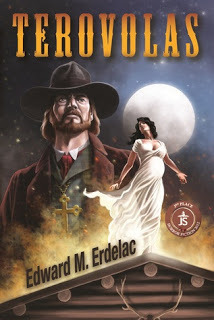
In turn, I tag the following Filthy Five:
Matt Cardin
Jayaprakash Satyamurthy
Jeffrey Thomas
Brian Sammons
Peter Rawlik
As now one of the It, I will answer the ten stock questions below, and then pay this hot potato forward.
Hope you enjoy.
__________________________________________________________________________
1) What is the working title of your next book?
I Am Death, Cried the Vulture, a joint collection of short fiction by me and my wife - author, editor, essayist, and intergalactic heartbreaker Ives Hovanessian.
2) Where did the idea come from for the book?
 My co-author. My co-pilotI was offered a short fiction collection deal last year, and then Ives and I were offered a joint collection deal at the beginning of this year. While both sounded great, and were huge honors, it seemed as time wore on and various issues arose, it made more sense to cut out middle management, fold my solo collection into the joint collection, and put out our debut joint collection ourselves (which was a goal of ours all along), allowing us complete control of cover, layout, format, platform, paper quality, binding, length, story selection, release timing, print run, deluxe editions, marketing, etc. Not to sound like control freaks, but all of those things matter to us, as we take the tactile and sensory experience of reading a timber and ink book very, very seriously, while also realizing the importance of having an eBook version available for those who prefer it. Moreover, as long time book buyers, we are keenly aware that the smallest things can be make or break when it comes to finding (and most importantly, keeping) a potential reader unfamiliar with your work, that only has a cover and a few blurbs to go on when deciding if they want to spend their hard earned money. That window is very narrow, and you need to grab an interested party immediately. Hence, we're going to publish it under our own banner, with I Am Death, Cried the Vulture serving as the launch release for SlaughterHaus Press, a boutique small press that will focus on writers and projects that we find exceptional, published with an eye on aesthetics and quality, respect for writers and artists, and a celebration of the enduring legacy of the physically printed written word.
My co-author. My co-pilotI was offered a short fiction collection deal last year, and then Ives and I were offered a joint collection deal at the beginning of this year. While both sounded great, and were huge honors, it seemed as time wore on and various issues arose, it made more sense to cut out middle management, fold my solo collection into the joint collection, and put out our debut joint collection ourselves (which was a goal of ours all along), allowing us complete control of cover, layout, format, platform, paper quality, binding, length, story selection, release timing, print run, deluxe editions, marketing, etc. Not to sound like control freaks, but all of those things matter to us, as we take the tactile and sensory experience of reading a timber and ink book very, very seriously, while also realizing the importance of having an eBook version available for those who prefer it. Moreover, as long time book buyers, we are keenly aware that the smallest things can be make or break when it comes to finding (and most importantly, keeping) a potential reader unfamiliar with your work, that only has a cover and a few blurbs to go on when deciding if they want to spend their hard earned money. That window is very narrow, and you need to grab an interested party immediately. Hence, we're going to publish it under our own banner, with I Am Death, Cried the Vulture serving as the launch release for SlaughterHaus Press, a boutique small press that will focus on writers and projects that we find exceptional, published with an eye on aesthetics and quality, respect for writers and artists, and a celebration of the enduring legacy of the physically printed written word.3) What genre does your book fall under?
Weird fiction, as a sub-genre. Horror if viewed more broadly. Anything from cosmic horror to ghost stories to tales of murder. The uncanny, the monstrous, the brutal, even the (twistedly) whimsical. This is dark stuff, with lots of range and plenty of genre blending. I think it has something for everyone who enjoys a wide swath of modern speculative fiction rooted in the Classics.
4) What actors would you choose to play the part of your characters in a movie rendition?
Hmm... As this question is most likely aimed at those participants discussing a novel, this might get a bit convoluted for raft of short stories.
 Ben Foster - Poster Boy for InsanityThat said, throwing out a few of my stories that will be included in my portion of the collection, I think Casey Affleck would make for an interesting Boyd in "The Screamer." Chris Evan could play the nameless protagonist in "Transmission." For "Flutes," I'd love to see Ed Harris or Harvey Keitel play Assistant Director French, while Ryan Gosling, Cillian Murphy, or Ben Foster would be an interesting Dansby.
Ben Foster - Poster Boy for InsanityThat said, throwing out a few of my stories that will be included in my portion of the collection, I think Casey Affleck would make for an interesting Boyd in "The Screamer." Chris Evan could play the nameless protagonist in "Transmission." For "Flutes," I'd love to see Ed Harris or Harvey Keitel play Assistant Director French, while Ryan Gosling, Cillian Murphy, or Ben Foster would be an interesting Dansby. For "In the Cave, She Sang," I think Christian Bale could do a bang-up Charles Manson traipsing through Death Valley on the eve of a very momentous decision. I think Mandy Patinkin would be a great father in the story "Twinkle, Twinkle," while James Caan and Susan Sarandon would be fantastic as the vacationing Vahlkamps in "Something We Ate." Robert Duvall and Gene Hackman as the fishing buddies in "Beer & Worms," and James McAvoy in "Corpus Arcanum." Daniel Day Lewis for my story "Old Whiskey," or any story I've ever written, will write, and would be forced to write if he said he wanted to play one of my characters.
5) What is the one-sentence synopsis of your book?
A collection of Weird fiction tales by T.E. Grau and Ives Hovanessian spanning the cosmos, the underground, and various shadowed places in between.
6) Will your book be self-published or represented by an agency?
Neither of us have sought out representation as of yet, and although we could have relied upon a publisher to put out I Am Death, Cried the Vulture, we both opted to do it ourselves, for the reasons listed above. DIY is the only way to ensure total satisfaction in the finished result.
7) How long did it take you to write the first draft of the manuscript?
Tough to say, as it's a collection of short fiction from two people, and is ongoing. In the end, it will cover our writing from the last three years (2010-2013). With our hectic schedules, various gigs, and penchant for rewrites, we're not the speediest scribes on the planet, but we do put in the work every day.
8) What other books would you compare this story to within your genre?
I dub "The Screamer" as an example of Lovecraftian Noir. Ives' story "Dog Will Hunt" has been compared to Lansdale, and is a Weird Western with a streak of wrathful black running through it darker than most anything else going. These are our two anchor tales, as they have received the most feedback. Our other stories pretty much run the gamut of fantastical and supernatural fiction as noted above. As for parallels to other books or authors, I think the collection will appeal to those people who read Richard Gavin, Matt Cardin, Simon Strantzas, Laird Barron, Landsdale, M.R. James, Bradbury, T.E.D. Klein, Ligotti, Lovecraft, Machen, Blackwood, etc., as the stories seem to twirl in those same wheelhouses, and have drawn thematic comparisons to many of the above from reviewers, readers, and peers.
9) Who or what inspired you to write this book?
The book was always going to be written, it just arrived sooner on the docket. But what inspired us to publish it ourselves was our goal of making a book interesting and worthy of purchase, and especially the time invested reading our book. In every phase. Inside and out. A customer - and especially a reader - is worthy of that respect and extra care, as they are investing days/weeks/months with our words and world. Because of this, we want to make the experience as wonderful as possible, as a way of showing thanks.
10) What else about the book might pique the reader's interest?
Picking up I Am Death, Cried The Vulture is a chance for a reader to experience two writers in one book, who have differing styles and stories to tell, but are bound by a love of the unsettling, the terrifying, and the beautifully macabre. A split collection, or an anthology of two. It will also provide the opportunity to pick up what will (hopefully) be the first of many books to come by Ives and I, mostly individual. We have plans for another joint collection, titled Dark Tales for Bright Children - which we will rename slightly, as people seem to think it's a kid's book, when in fact it is a very adult book about very bad things done by and to children. Cheery stuff, right? Welcome to Grau Haus...
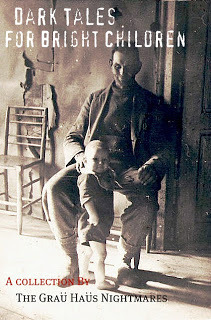
+ + +
Happy Thanksgiving, all. Eat, drink, sleep, drink, eat, and be very, very merry. Life's too short to not celebrate the lovely times.
Please keep an eye out for the responses of the above-named Now Its this coming Wednesday, November 28th.
Published on November 21, 2012 15:22
November 3, 2012
All Hallows Eve 2012: The Cosmicomicon Goes Hoody, Hunkers Down Local, and Celebrates Dia de los Muertos With Fellow Angelinos
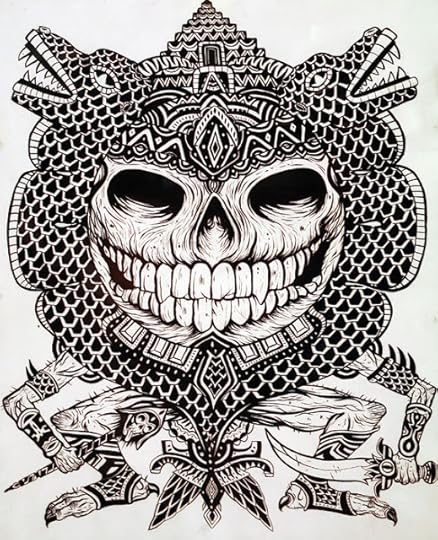
Instead of our usual Euro-centric celebration of All Hallow Eve here at The Cosmicomicon , this year we've decided to do something a little bit different, and focus on a holiday that not only treads heavily on the Dark Plane, but jovially embraces the idea of Death much more than Halloween ever dared. This ain't about Stingy Jack. This is about something far more eldritch...
Trick-or-treating in nearby South Pasadena on Wednesday night aside, for our annual TC holiday posting, we've traded hollowed-out gourds for sugar skulls. Scary rubber masks for skeletal makeup (rendered exquisitely by Ivy, as per usual). October 31st for November 1st and 2nd. We're going New World Old(est) School.
For 2012, The Cosmicomicon is giving a nod to the Aztecs, and celebrating Dia de los Muertos , known to us pasty-ass Anglos as Day of the Dead. This practice of honoring - indeed, celebrating, in a refreshingly jovial way - the dearly departed was discovered by Spanish explorers (invaders) round about 500 years ago, and was deemed by the staunch Catholic interlopers as a heretical practice by the newly arrived Culture Marms. Although his work is under lock and key, give Octavio Paz some love here.
Culturally, what followed is pretty standard - the attempt to systematically wipe-out a purportedly "pagan tradition" that had nurtured the incredibly advanced Aztec people for over 3,000 years. Various forms of Dia de los Muertos (obviously named something different in the Aztec tongue) had been observed by millions of adherents in the Western Hemisphere whilst East Hem Europeans were pissing in caves and trying to grasp the concept of proper clothing and agriculture. Didn't matter. Once the Europeans arrived, this horrid tradition had to be stomped. They tried. So many died... But the tradition survived, somehow, thank the gods....
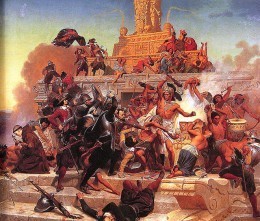
With such a vast gulf of historical time, The Day of the Dead immediately conjured images of Egyptian and Sumarian death rituals that reenforces my shakily supported contention that the exceptionally advanced rise of Mediterranean (Atlantian) culture during the B.C.'s had offshoots in the Western (and Eastern) Hemisphere, belying contact betwixt the two far flung land masses. But I digress... Prehistorical alien interaction, and all of that.... Someday the TC will go there, but let's stay on topic, shall we?
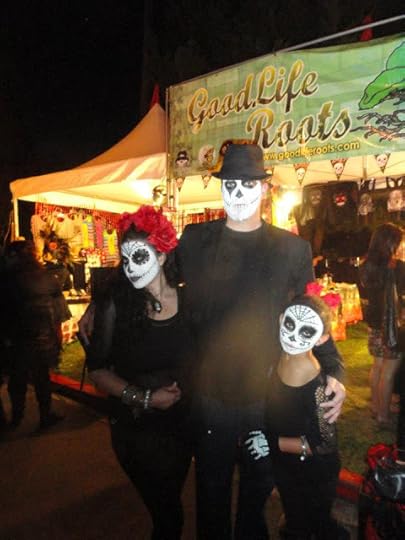 The Gawking Dead: Ives, T.E., Fish, shopping for terminally expired trinket Instead of trying to sound intelligent and well versed in Dia de los Muertos lore, I'll cut and paste from the cultural think tank that is Day of the Dead page on Wikipedia:
The Gawking Dead: Ives, T.E., Fish, shopping for terminally expired trinket Instead of trying to sound intelligent and well versed in Dia de los Muertos lore, I'll cut and paste from the cultural think tank that is Day of the Dead page on Wikipedia:Day of the Dead (Spanish: Día de los Muertos) is a Mexican holiday celebrated throughout Mexico and around the world in other cultures. The holiday focuses on gatherings of family and friends to pray for and remember friends and family members who have died. It is particularly celebrated in Mexico, where it is a national holiday, and all banks are closed. The celebration takes place on November 1 and 2, in connection with the Catholic holidays of All Saints' Day and All Souls' Day. Traditions connected with the holiday include building private altars honoring the deceased using sugar skulls, marigolds, and the favorite foods and beverages of the departed and visiting graves with these as gifts. They also leave possessions of the deceased.
Scholars trace the origins of the modern Mexican holiday to indigenous observances dating back hundreds of years and to an Aztec festival dedicated to the goddess Mictecacihuatl. The holiday has spread throughout the world: In Brazil, Dia de Finados is a public holiday that many Brazilians celebrate by visiting cemeteries and churches. In Spain, there are festivals and parades, and, at the end of the day, people gather at cemeteries and pray for their dead loved ones. Similar observances occur elsewhere in Europe, and similarly themed celebrations appear in many Asian and African cultures.
This embrace of a Aztec/Mexican celebration of death is only fitting, as Grau Haus perches on a sturdy, palm-shaded cliff on the far northeast corner of Los Angeles, home to a mostly Latino population (currently weathering a slow onslaught of hipster gentrification). This is Brown Town, and us interlopers are just paying rent.
 I'd die for these two stunning Dead Girls.So, as Ivy is a child not born but stripling-raised in the heart of Hollywood, and as Fish is truly a hatched and bred Angelino (with my red Nebraska ass playing piggy back), we decided this year to venture out and experience a true Los Angeles (which is majority Latino) festivity that was alien from our understanding of Halloween.
I'd die for these two stunning Dead Girls.So, as Ivy is a child not born but stripling-raised in the heart of Hollywood, and as Fish is truly a hatched and bred Angelino (with my red Nebraska ass playing piggy back), we decided this year to venture out and experience a true Los Angeles (which is majority Latino) festivity that was alien from our understanding of Halloween. 
Just across town - about 20 minutes on the 101, sans traffic - nestled under the shadow of the damnable Siren Sign on the hill, is Hollywood Forever Cemetery, the final resting place for the human remains of Rudolph Valentino, Peter Lorre, and Douglas Fairbanks (as well as a grip of well-appointed Armenian, Russian, and Jewish folk). This is the spot where Ives, Fish, and I (and various family and friends) spent most of our last two summer Saturdays, frolicking amongst the carefully interred dead, enjoying amazing DJs, popping corks, and watching an array of interesting films via Cinespia.
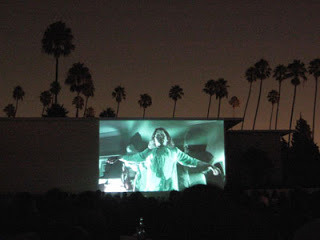
Anyhoot, let me stop clacking, and bust forth with the Day of the Dead pictures, which are far more compelling than any of my blathery verbiage.
Thank you for reading so far. Let the gallery begin:
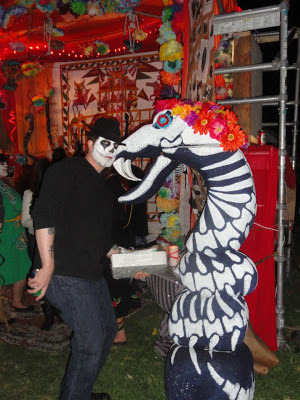 Wrasslin' with The Serpent. Adam ain't got shit on me. I even took off my jacket. That's commitment, folks.
Wrasslin' with The Serpent. Adam ain't got shit on me. I even took off my jacket. That's commitment, folks.
 It's probably just an octopus (and delicious ceviche ingredient), but to me, it's most definitely You Know Who.
It's probably just an octopus (and delicious ceviche ingredient), but to me, it's most definitely You Know Who.
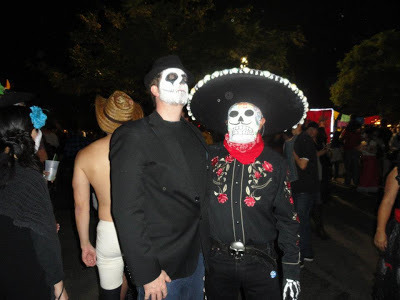 The Tourist (in the oddly bunched jacket) and the Resident.
The Tourist (in the oddly bunched jacket) and the Resident.
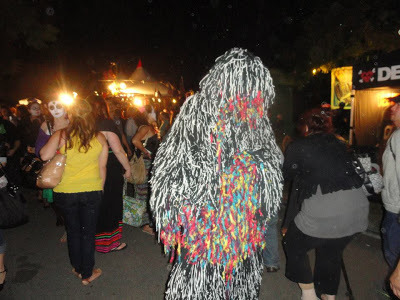 The Shambling Mound (of Yarn).
The Shambling Mound (of Yarn).
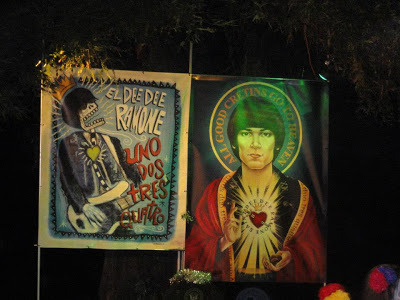 St.. Bruce Lee, Deliverer of Death With a Single Blow, Patron Saint of "All Good Cretins Go to Heaven." The first poster I ever tacked to my wall was of this man.
St.. Bruce Lee, Deliverer of Death With a Single Blow, Patron Saint of "All Good Cretins Go to Heaven." The first poster I ever tacked to my wall was of this man.
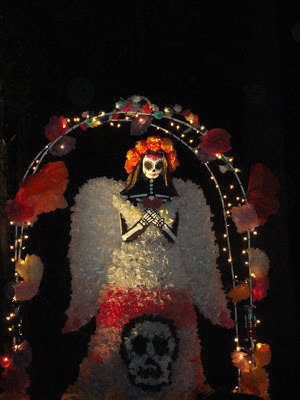 Soul Sister of Ives.
Soul Sister of Ives.
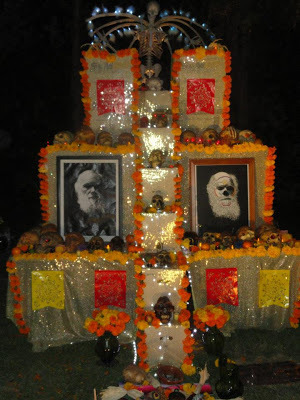 When I saw this, I immediately thought of my favorite Atheist S. T. Joshi... and the bones of finches.
When I saw this, I immediately thought of my favorite Atheist S. T. Joshi... and the bones of finches.
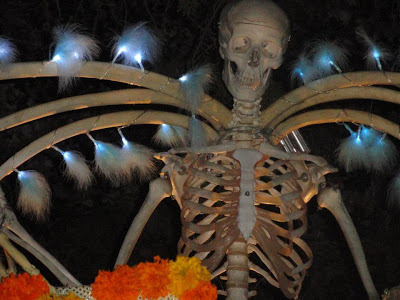 Grinning Angel of Death. The epitome of Day of the Dead.
Grinning Angel of Death. The epitome of Day of the Dead.
 A Gathering of The Ancients
A Gathering of The Ancients
 Escorting the Bride of Death down the aisle to meet her Groom.
Escorting the Bride of Death down the aisle to meet her Groom.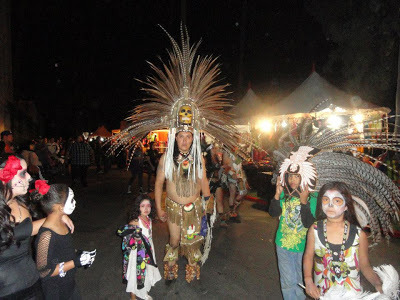 A beautiful embrace of the roots.
A beautiful embrace of the roots.
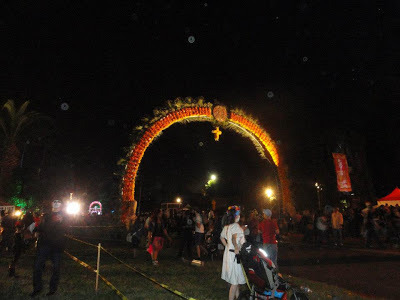 A Portal, melding the new with the profoundly old.
A Portal, melding the new with the profoundly old.
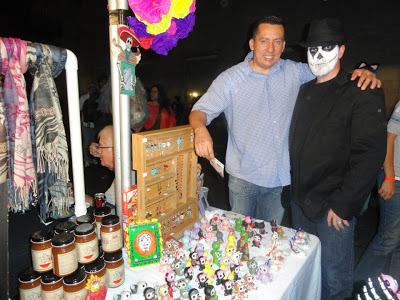 Posing with a monger of dead cuties. Fish picked out a Burtonesque zombie kitten. Of course she did.
Posing with a monger of dead cuties. Fish picked out a Burtonesque zombie kitten. Of course she did.
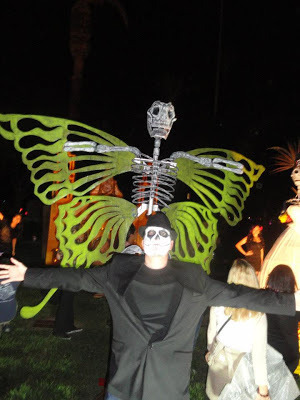 Mausoleum winds beneath my wings.
Mausoleum winds beneath my wings.
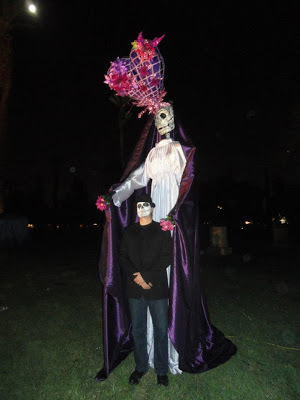 Partially enveloped in in the Eternal Mysteries.
Partially enveloped in in the Eternal Mysteries.
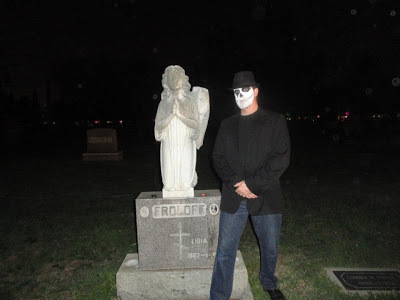 Guardian Angel and respectful Seeker. Leg cocked to stay off hallowed ground.
Guardian Angel and respectful Seeker. Leg cocked to stay off hallowed ground.
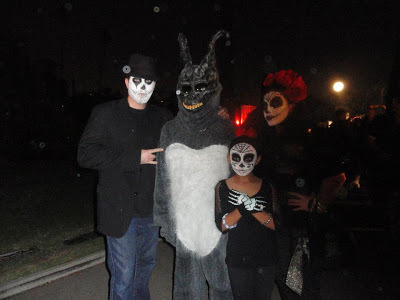 A relative, hanging with the nuclear family.
A relative, hanging with the nuclear family.
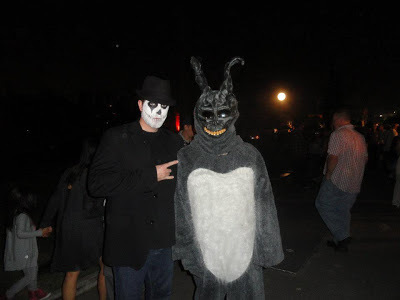 Bro time with a true Nightmare.
Bro time with a true Nightmare.
 The Girls of Grau Haus, posing with a Ghoul obviously hiding his giddiness under his sombrero.Very few things are forever these days. Zales (and vast, cutthroat South African gem interests) says it's a diamond. Possibly. But I know for certain that Hollywood will be forever, as with Death, and the Day we celebrate those who have passed on to the Great Unknown. May they be happy, content, and pop in from time to time, to sip a cocktail and nibble a nice snack left for the those who have departed this mortal coil, but who will never be forgotten.
The Girls of Grau Haus, posing with a Ghoul obviously hiding his giddiness under his sombrero.Very few things are forever these days. Zales (and vast, cutthroat South African gem interests) says it's a diamond. Possibly. But I know for certain that Hollywood will be forever, as with Death, and the Day we celebrate those who have passed on to the Great Unknown. May they be happy, content, and pop in from time to time, to sip a cocktail and nibble a nice snack left for the those who have departed this mortal coil, but who will never be forgotten.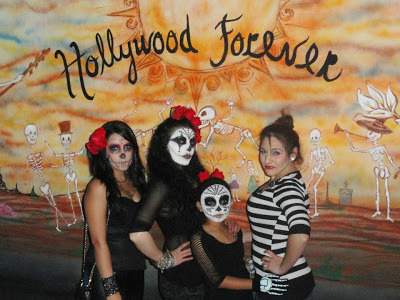
Happy Dia de los Muertos, my Mexican/Mestizo brothers and sisters, and all those getting up to speed (like me). Hail the Dead. Hail the Living. Hail the Living who honor the Dead and those who are unafraid to look into the Ultimate Abyss and smile, unafraid of the adventure to come. May I be one of those brave souls someday.
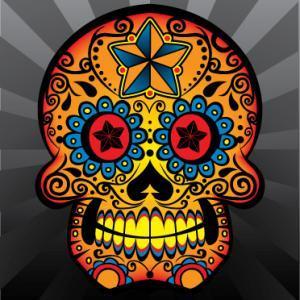
BTW, Ives, Fish, and I have tentative plans to set up an Alter Site at the Hollywood Forever Day of the Dead fandango next year. If we have the time and gumption (read as: time between ever-present deadlines), trust that it'll rep all the best of Weird fiction, Lovecraftiana, and a beautifully rendered (have you SEEN Ives' design work?) tribute to the sad beauty of those persons, places, and things that have shrugged off this plain and stepped boldly into the mysterious environs of the Great Beyond.
(please explore Nobel Prize winner Octavio Paz for a) amazing poetry, and b) some damn fine background on Dia del los Muertos)
Published on November 03, 2012 05:21



